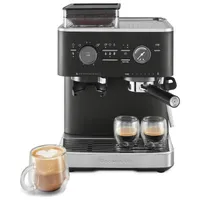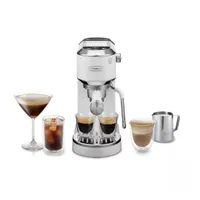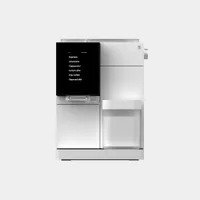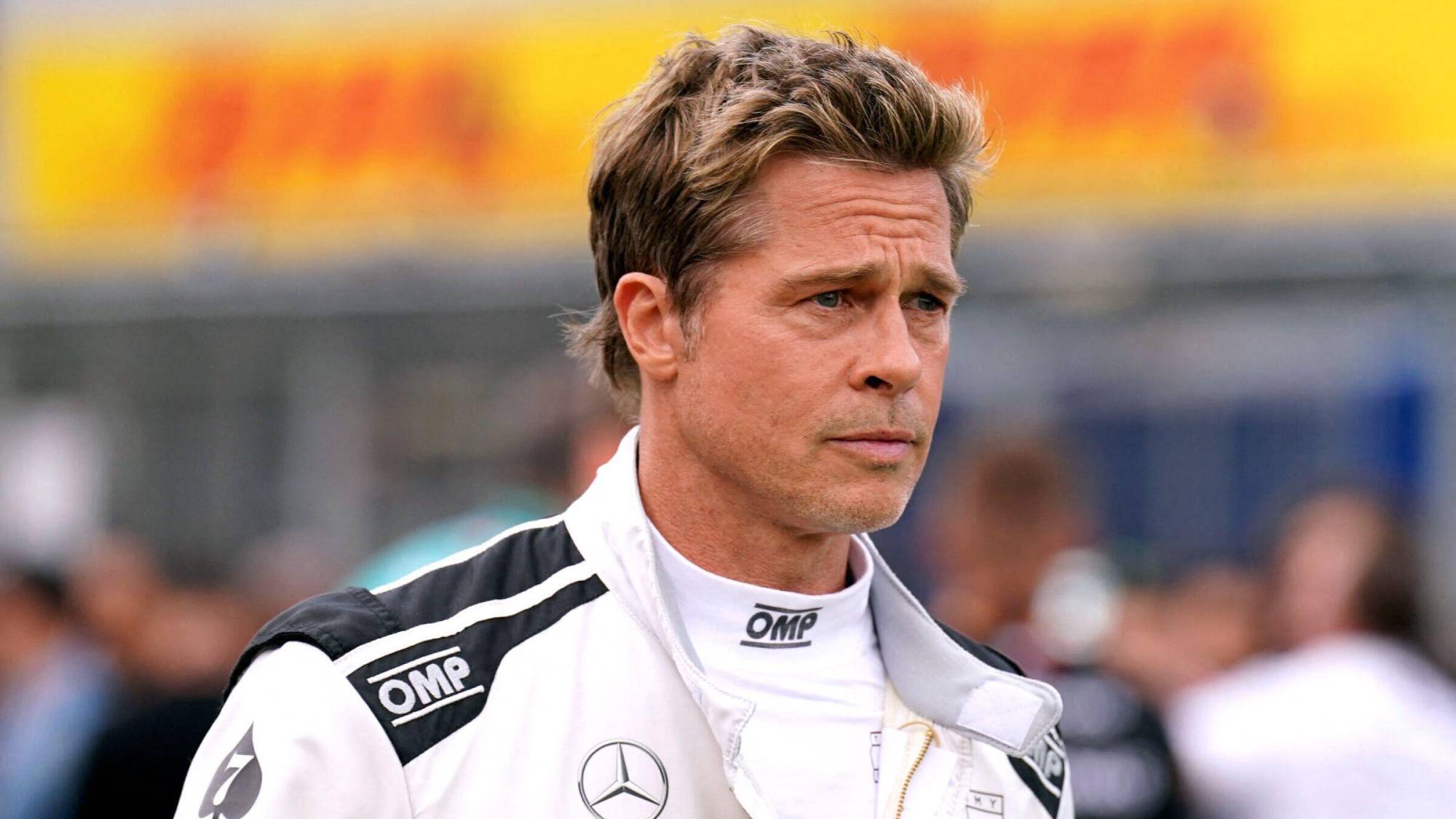Best espresso machines 2025: top picks from a certified barista
What happens when a coffee enthusiast and a professional barista review and rank espresso machines? This guide, that's what.
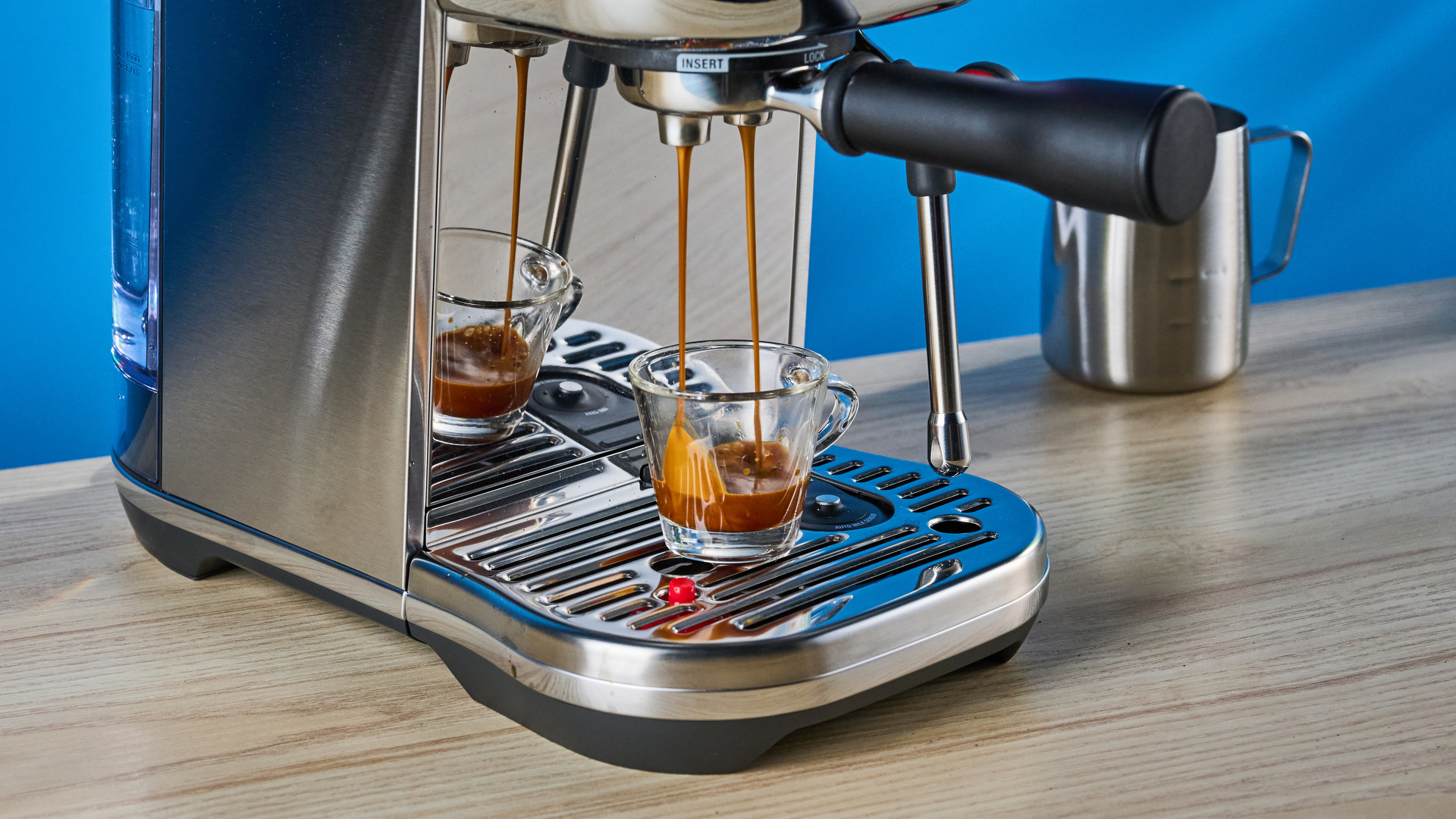
- Quick list
- How we test
- Types to consider
- Key terminology
- Best overall
- Best compact
- Best budget
- Best for features
- Best superautomatic
- Best premium
- Best under $250
- Best steam wand
- Best looking
- Best for enthusiasts
- Meet the testing team
- Also tested
- How do espresso machines work?
- Why are espresso machines so expensive?
- Espresso machine FAQs
I bought the wrong espresso machine once, and it was an expensive mistake. With a taste for great coffee but limited knowledge of how to make it, I found one that looked good, had great reviews, and was on sale, and took the plunge. While it was a beautiful machine, it required far too much know-how for a newbie like me to get the most out of it.
Now that I'm a Specialty Coffee Association-qualified barista, it's easy to see where I went wrong. There are so many coffee makers on the market, and for the average first-time buyer, there's a lot of dense terminology to wade through.
That's why I've put this guide together: it breaks down my tried-and-tested recommendations for the best espresso machines you can buy, but also walks you through the things you need to know before you buy a machine, as well as how to get the most out of each option.
There are three main types of domestic espresso machines — manual, automatic, and superautomatic — and each is suited to a different type of buyer. For confident home baristas who want a good machine and don't want to spend too much, the Breville Bambino Plus will be your best friend. But if you want that extra bit of assistance, I think the De'Longhi La Specialista Touch is the best espresso machine for most people.
Then there are superautomatic espresso machines, which allow you to simply press a button and let your machine do all the hard work for you. If you like the sound of a hands-off option, the KitchenAid KF8 is my top pick.
The quick list

Whether you’re a coffee newbie or a coffee expert, the Touch is a wonderful machine perfect for most people, especially those who appreciate a smart touch.

The Breville Bambino Plus offers smart steaming in a compact frame. It doesn't have an in-built grinder, but it’s compact in design, straightforward to use and brews delicious espresso, cup-after-cup.
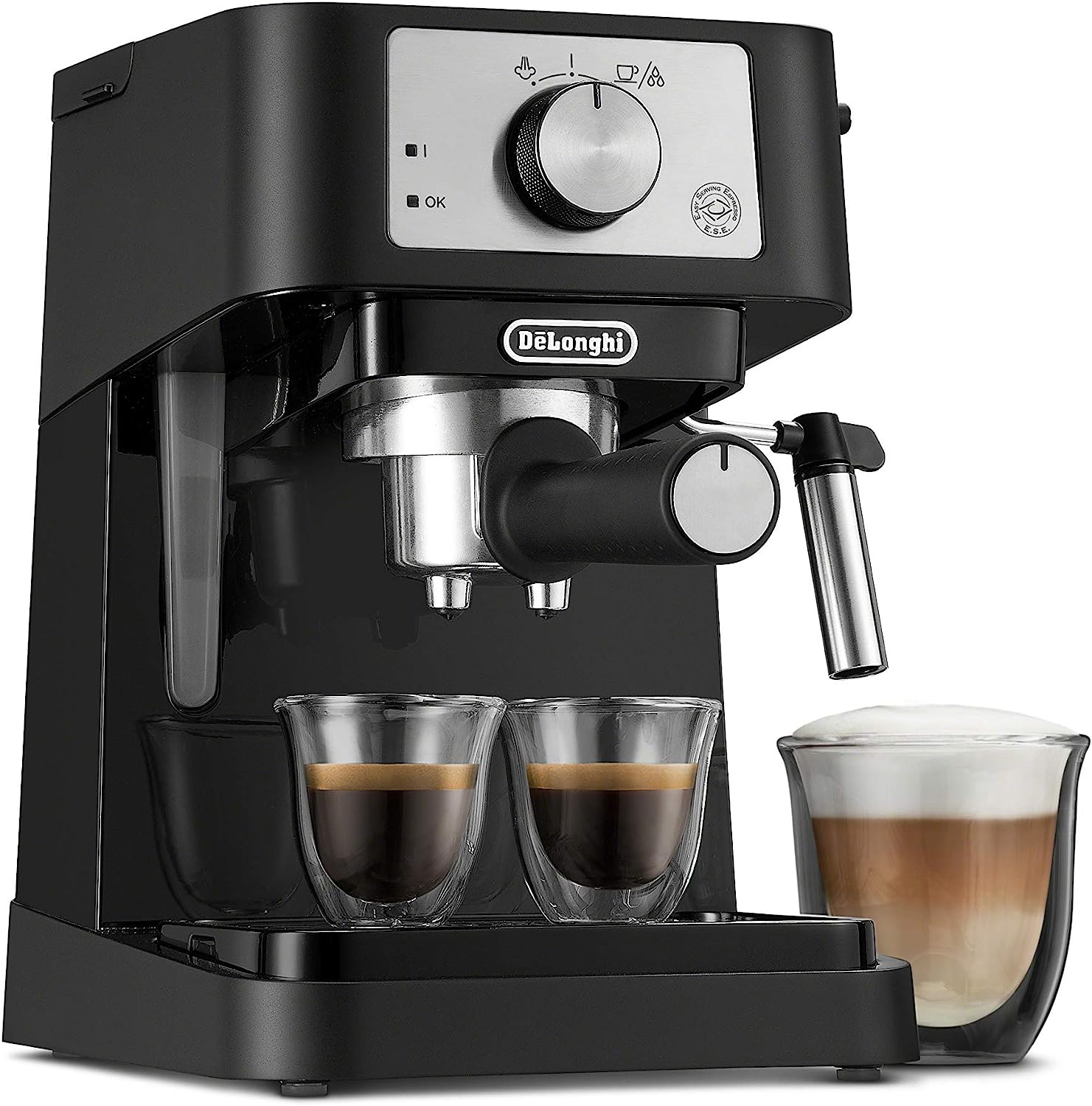
The De'Longhi Stilosa is one of the best espresso machines we've tried when it comes to value for money. It punches well above its $150 price tag, with a powerful steam wand and decent extraction.

We loved the original Ninja Luxe Café, but the new Pro series is even better. With an improved design including a hot water dispenser, XL milk jug and tamping arm, it's ideal for those starting on their espresso journey.
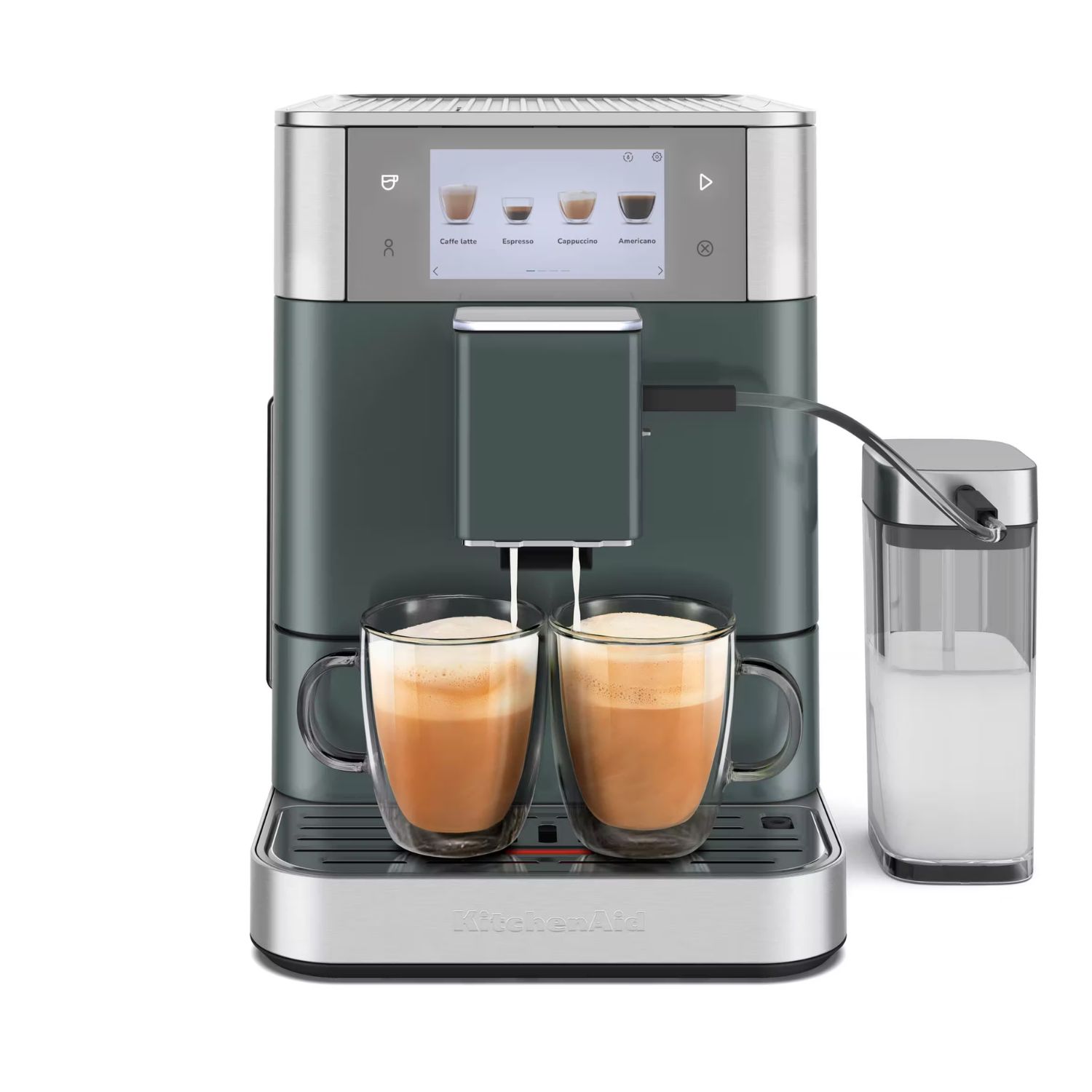
Erin described this machine as a coffee-making robot, which perfectly captures how it works, and why it's so clever. It makes a myriad of drinks with the touch of a button, and it does so quietly and powerfully.
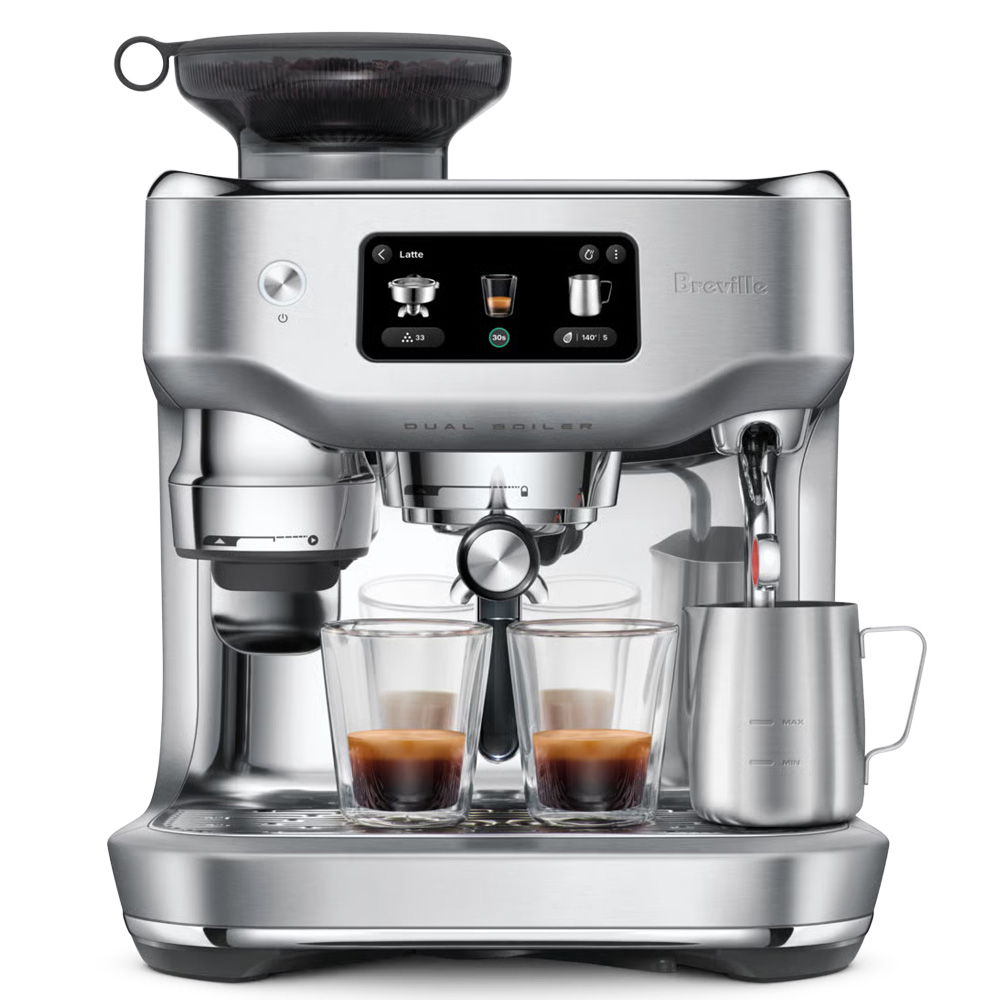
The latest release from Breville, the Oracle Dual Boiler is the obvious choice if you want a brilliant brand and no cutting corners. It's what you'd get if a computer and a coffee machine had a baby.
How we test the best espresso machines
We review a lot of espresso machines at Tom's Guide. Very few of them make it into our buying guides, but you can see a comprehensive list of other models we've tested at the bottom of this guide.
When it comes to testing espresso machines, there's a lot of room for human error. In order to minimize this, I work closely with a team of true coffee experts, from former baristas to serious home baristas. Every review you'll read on Tom's Guide will be from a true espresso enthusiast who can tell their flat whites from their cappuccinos and their arabica from their robusta.
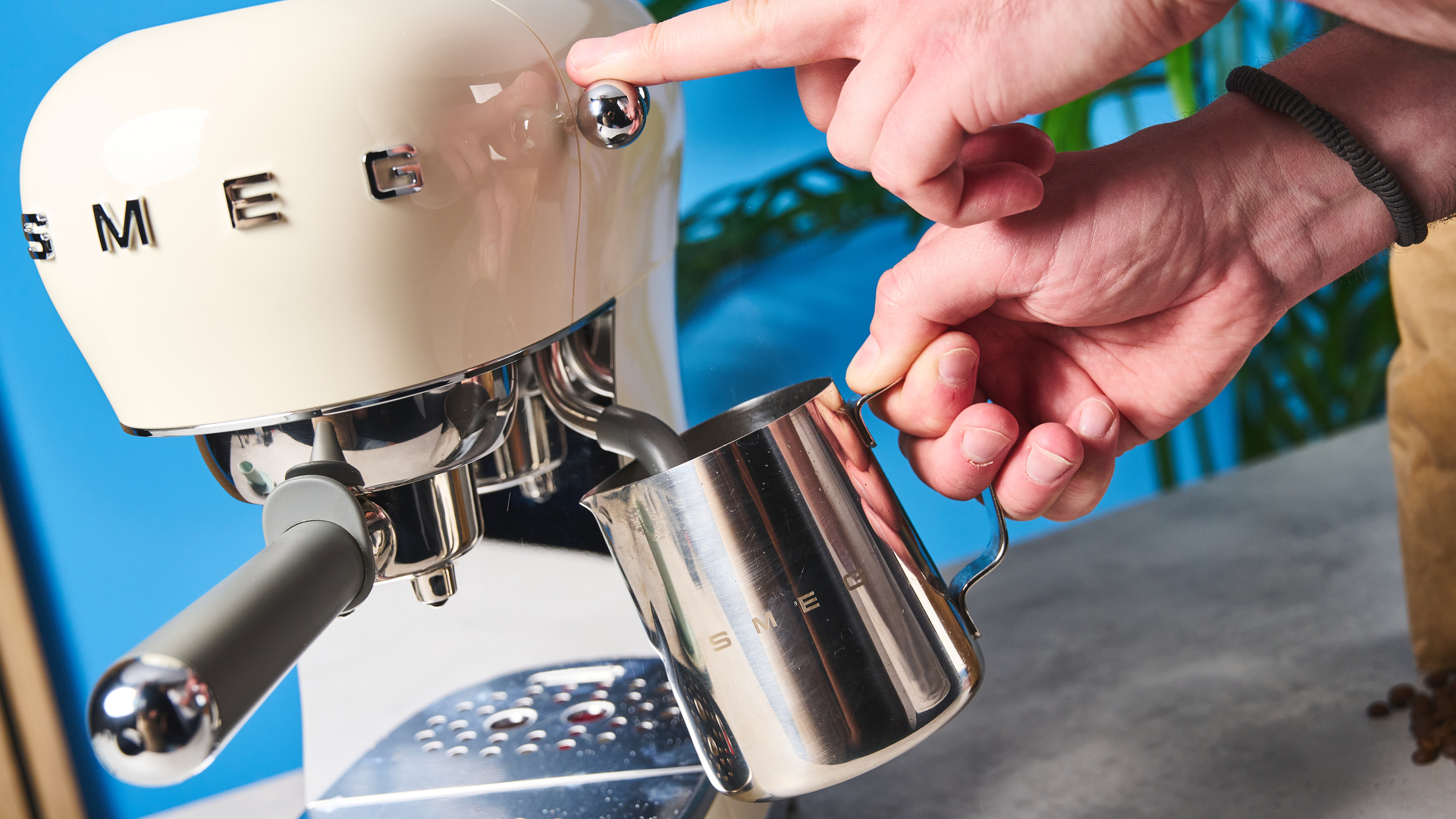
We consider a huge range of factors when evaluating espresso machines. Here's a non-exhaustive list of the things we test for:
Ease of use: You shouldn't have to be a pro to work an espresso machine. These appliances are designed to make life easier, so while it's fair to expect a learning curve if you opt for a manual machine with lots of hands-on features, we mark machines down for any quirks or fiddly features that will make day-to-day use harder for the average buyer.
Ease of cleaning: Some machines are splashy, messy, and get greasy from the touch of a button. These are workhorses, sure, but they're also meant to look nice, so we evaluate whether they spill grounds, splatter milk, or will require any major upkeep with each review.
Value for money: Even a budget espresso machine can be expensive, so we always consider whether a machine is priced competitively when putting it to the test. If we wouldn't recommend our friends spend their money on a machine, we wouldn't recommend it to you, either.
Grinding: If a machine has an in-built grinder, we put it through the same testing that we use when evaluating the best coffee grinders. After all, the quality of your grinder plays a massive part in achieving a good extraction. It's the single most important part of any espresso-brewing process. We evaluate the range of grind sizes on offer with every machine (you'll want a very fine consistency, but this will vary depending on the bean you use), as well as how much coffee a machine grinds automatically. A lot of enthusiasts brew using ratios, so we like to weigh the grounds before we brew for good measure.
Brewing: Albeit an important step, this is also the simplest to test. Whether a machine can brew well is dependent on the performance of the grinder, but we know we've got a quality coffee if it brews at that sweet spot between 190 to 200°F (88 and 93°C) and we get between 25-30ml of espresso. We use a coffee scale to test this, just to be extra thorough.
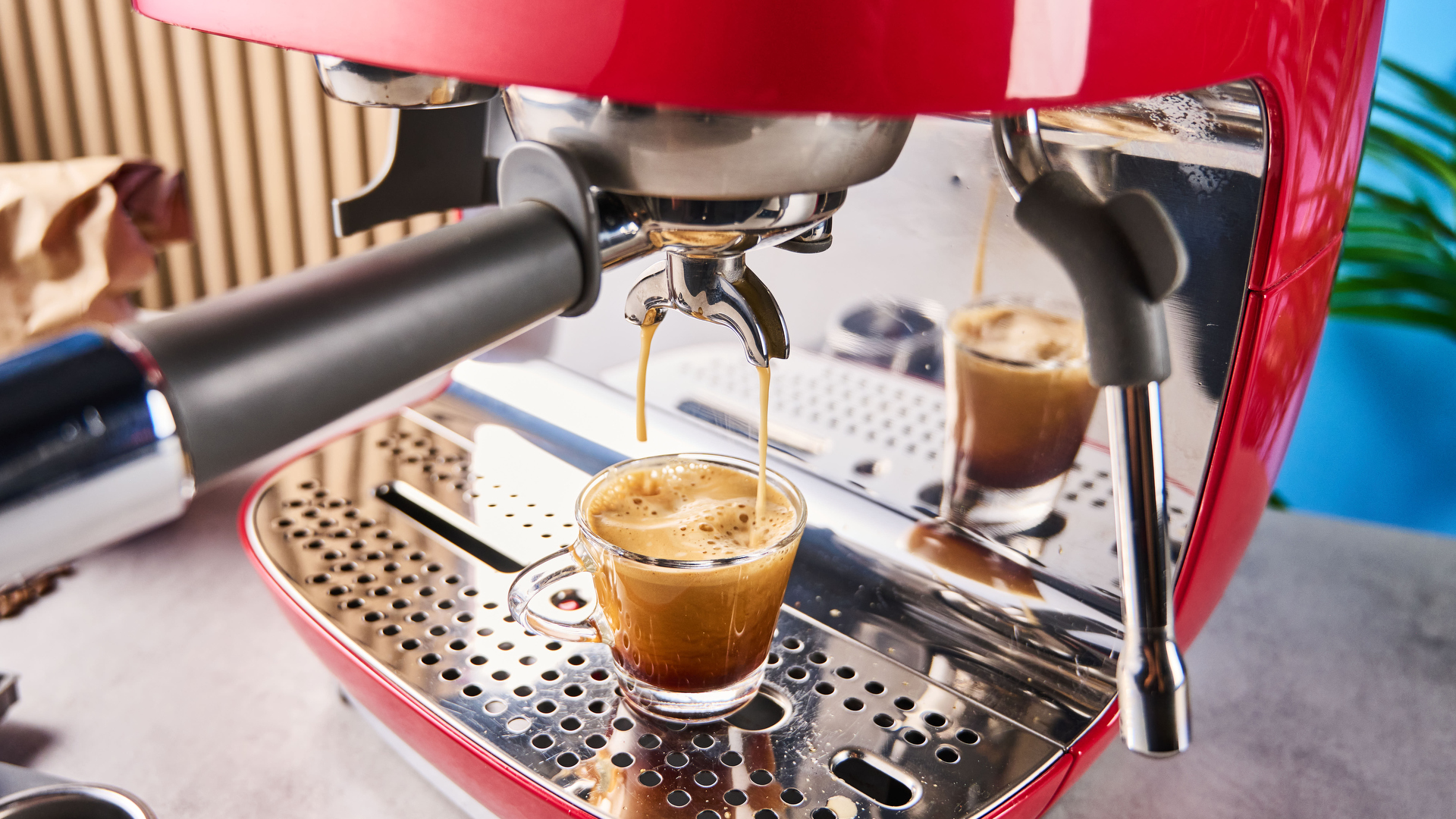
Taste test: Metrics aside, it's all in the taste-test. We buy high-quality coffee (currently, we're using a subscription to Hard Lines' specialty coffee) that's freshly-roasted to give our machines the best possible chance of brewing a brilliant espresso. And if it tastes too bitter or too tart, we know it's not the beans' fault! If the coffee tastes too grassy, it suggests the machine doesn't brew hot enough, and if it's burnt-tasting, that's a sign that it's not got good temperature regulation and is scorching our grounds.
Milk steaming: Steam wands need to be powerful, ergonomic and responsive. A great wand will not only heat your milk but also help to create a powerful vortex, which will add texture and incorporate air into your milk jug. I'll get more into how to use a steam wand below, but you best believe that if former barista Erin can't get a good texture from a steam wand, there's no hope for a home user.
Super-automatic espresso machines will often feature milk dispensers that automatically froth your milk and pour it into your mug. This is really convenient if you don't like the idea of learning to steam milk by hand, but just so we're clear, these machines don't steam your milk. They simply heat it and inject some bubbles as they pour into your cup. It gets the job done, but it's not going to compete with a coffee shop-quality flat white.
Longevity: You need to be prepared to look after an espresso machine. They block easily if you don't descale regularly, and your group head and steam wand will need to be flushed out periodically. This aside, we've also tried machines that simply don't feel like they're built to last. Where possible, we like to hang onto a top pick for prolonged home use and testing. That way, we can update our guide if it doesn't seem built to last. Our number one, the De'Longhi La Specialista Opera, is currently living with Erin as her home machine, allowing us to continue to evaluate its position in this guide.
What are the main types of espresso machine?
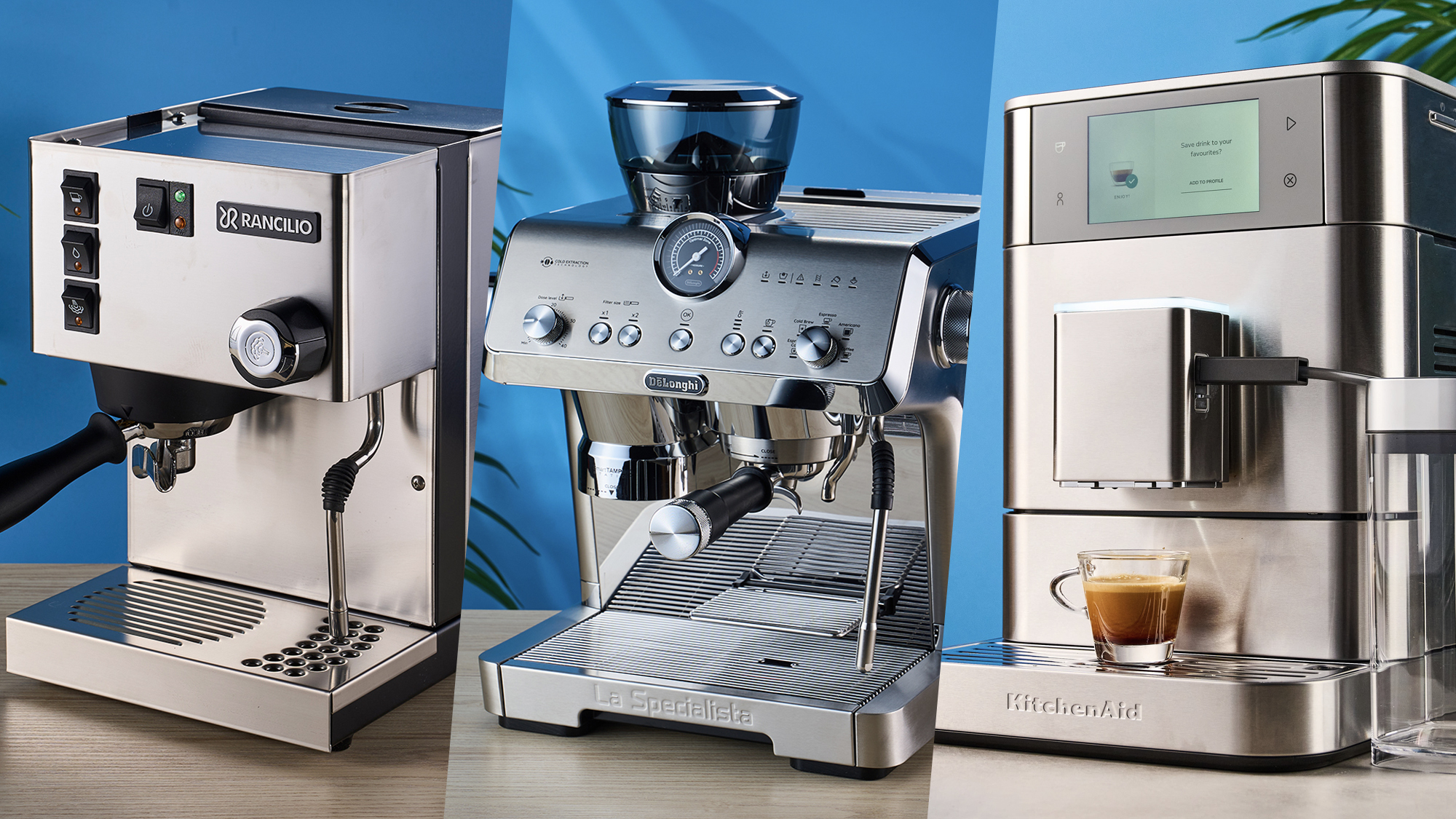
This question used to be a lot more simple to answer: there's manual, and there's super-automatic! However, things have changed a lot in the last few years, and now there's an increasing number of machines that sit somewhere in between.
In truth, it would be easier to characterize types of espresso machine as a spectrum, all the way from lever pump machines like La Pavoni to one-touch super-automatics like Jura.
But to make life easier, I've divided the domestic machines in this guide into three categories:
- Manual: A manual machine will require you to get hands-on. This category can span from a fully lever-operated espresso machine to a conventional Breville Barista Express. These machines offer little assistance, which is great if you want to get super technical with your coffee, but if you’re not the most experienced, they might make it harder to get a consistently good brew.
- Automatic: An automatic espresso machine will feature more assistance than a manual option but often look very similar, using a portafilter and typically a steam wand over a milk dispenser. From hands-free milk steaming to guided grinding, this is a growing market in the coffee machine scene and I, for one, am here for it. For examples, think of the Ninja Luxe, or the De’Longhi La Specialista Touch. These machines are designed to still make you feel like a barista, but don’t require years of experience. However, you’ll typically have to pay a bit more for these automated features.
- Super-automatic: A super-automatic coffee machine from the likes of De’Longhi and Philips will do all the grinding, tamping, brewing, and often milk steaming, for you. They often have a more boxy design that keeps the craft of brewing out of sight, which makes it harder for you to intervene or experiment. These machines are great for people who aren’t that interested in getting involved in the process of brewing coffee, but want a machine that will deliver a consistent brew at the touch of a button. At an entry level, they can cost less than you might think, but they can get very expensive if you opt for premium brands like Jura.
The ABC's of espresso machines
Espresso machines are pretty complicated, which is why I did a dedicated Specialty Coffee Association course before compiling this guide. While I’ve tried to make it as accessible as possible, there is some terminology you might need to learn to understand the reviews below. Here are the ABC's of espresso machines.
- Basket: An espresso machine will usually come with multiple basket sizes. It’s the removable insert to your portafilter that holds your coffee grounds.
- Extraction: You extract espresso from your coffee grounds, and a good espresso is a result of a good extraction. You might also see me say ‘pull’. This is a reference to a more manual brewing style which involves a manual lever, but even in modern espresso machines we still say that we ‘pull’ a shot of espresso.
- Group head: This is where the magic happens. It’s the bit of your espresso machine that you lock your portafilter into, and which dispenses hot water into your puck.
- PID: PID stands for Proportional-Integral-Derivative controller. A PID will ensure that the temperature during use is consistent, making these machines more convenient for most people to use.
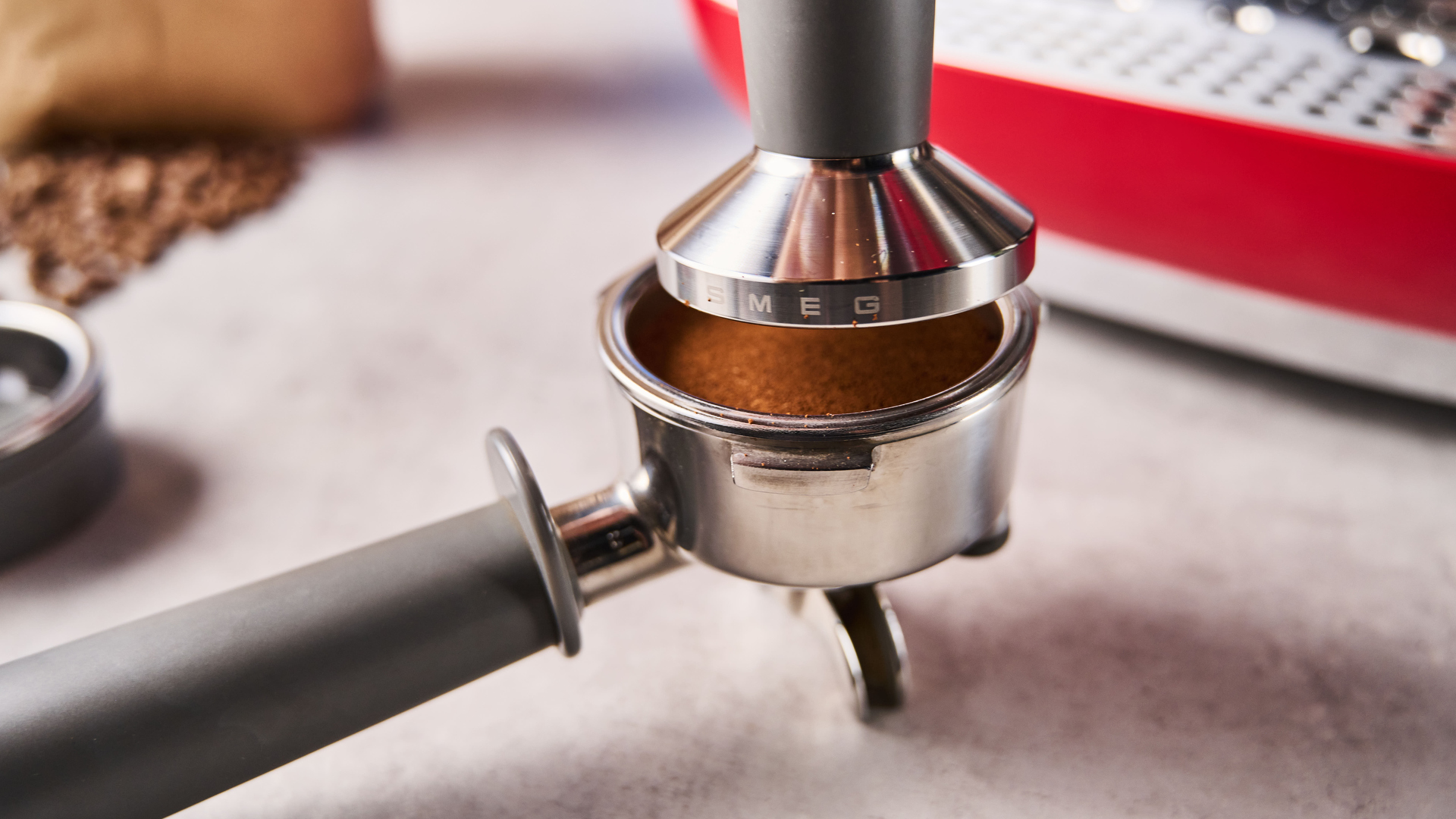
- Portafilter: That handle that holds your filter basket is called a portafilter. When testing, I look out for weighty and well-made filters that will stand up to use after use. But if you get a machine with a flimsy one, they’re easy and cheap to upgrade.
- Puck: Puck wasn’t a word that featured on my initial list, but after writing it plenty of times when writing this ABCs list I thought it might be best to add it in. When you tamp your coffee it forms a ‘puck’. That’s also what you tap out when removing your used grounds from the portafilter.
- Steam wand: This one is quite self-explanatory, but your steam wand is the long arm at the side of your espresso machine (usually on the right side) that pumps out steam. It’s used to texturize milk for milk-based coffee drinks such as latte and cappuccino.

- Tamp: Tamping is the process of compressing your coffee grounds to form one solid puck of coffee. Doing this consistently will ensure there’s even pressure when pulling your espresso shot. Some espresso machines will require you to use a tamper by hand, others have in-built tamping functions, and super-automatic machines will do the whole thing for you, as if by magic.
- Volumetric dosing: An espresso machine with volumetric dosing will pour a specific amount of espresso, typically a single shot or double shot, and stop pouring automatically. Most modern machines have this feature.
Best espresso machine for most people
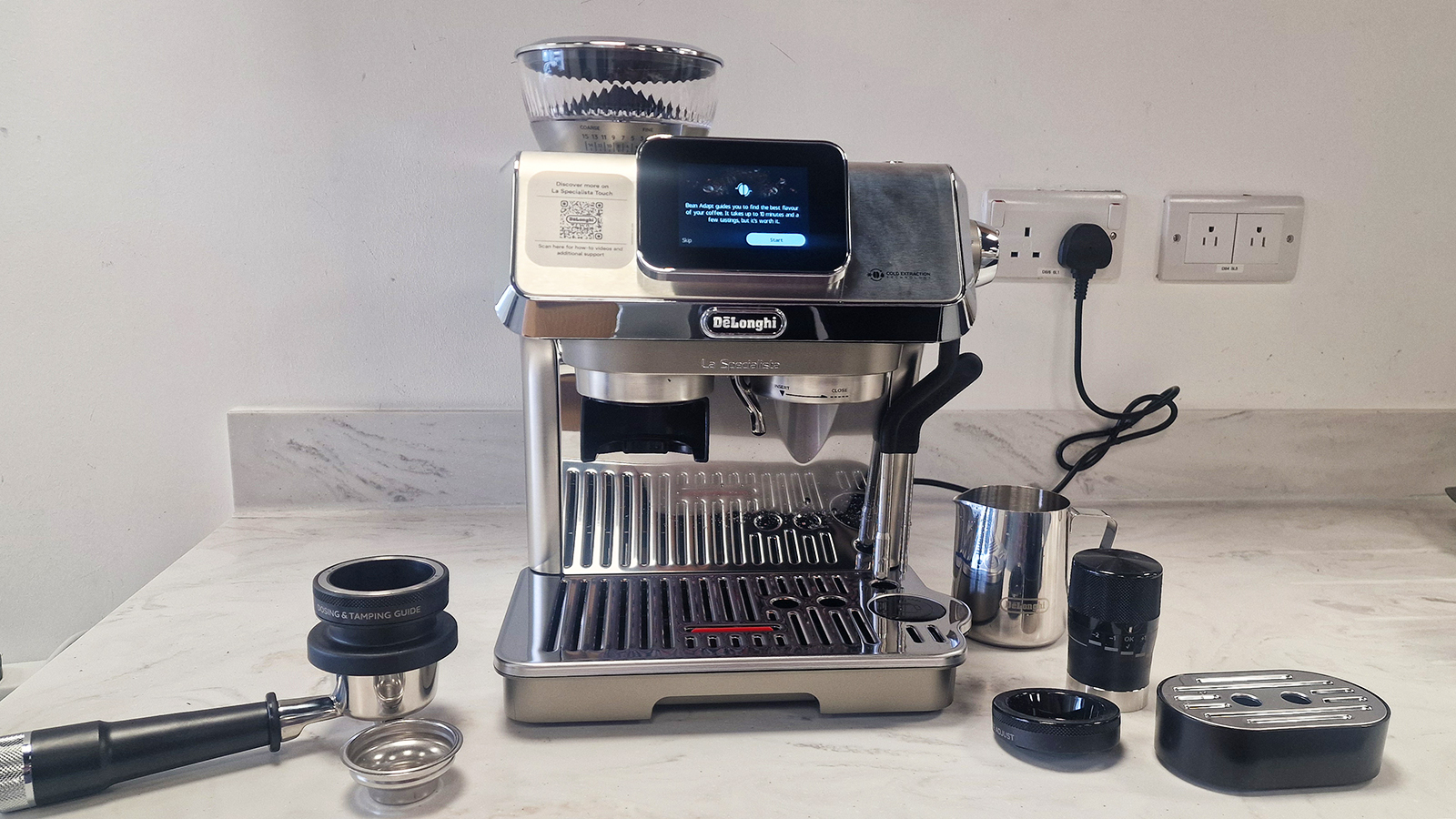
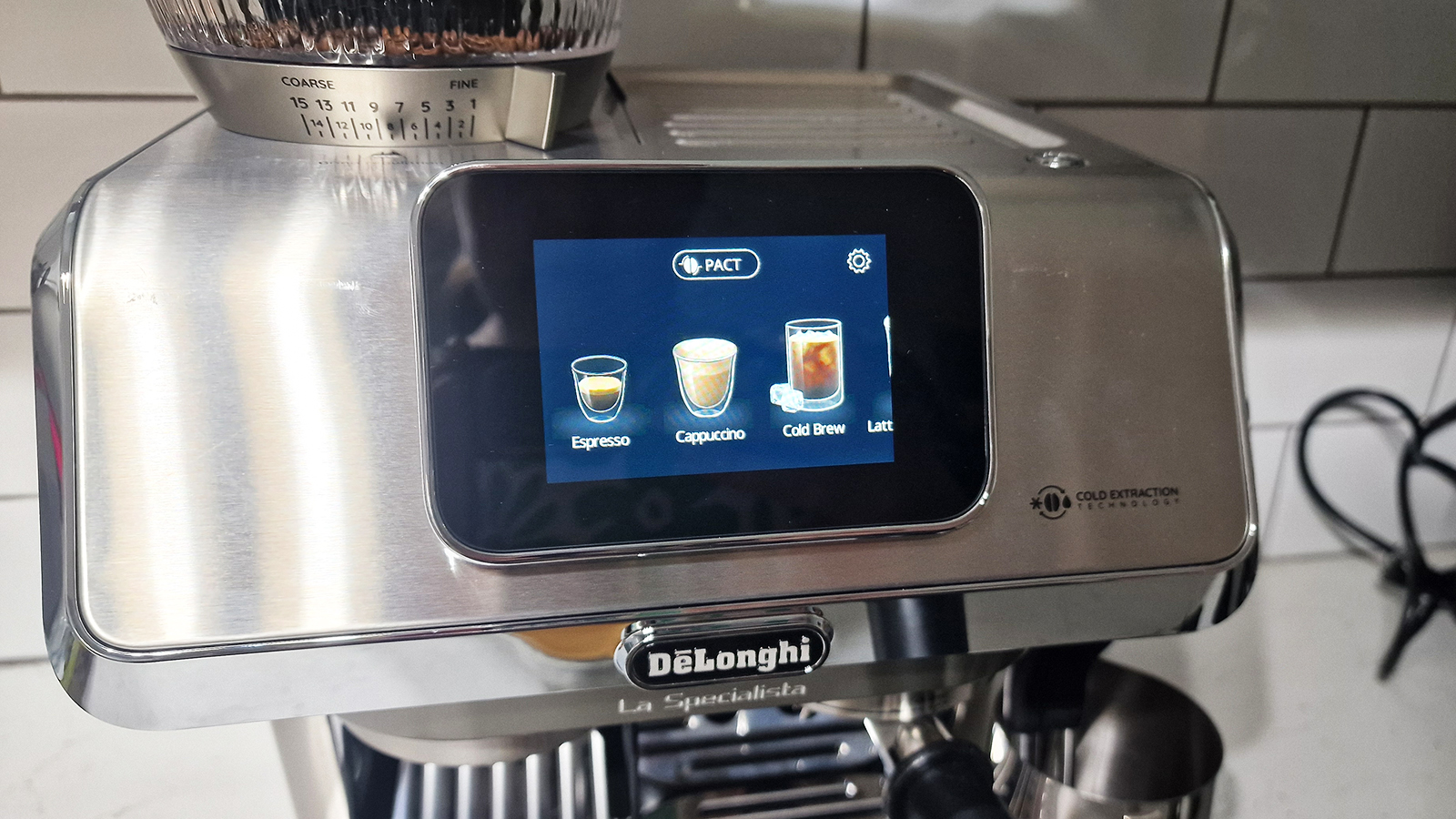

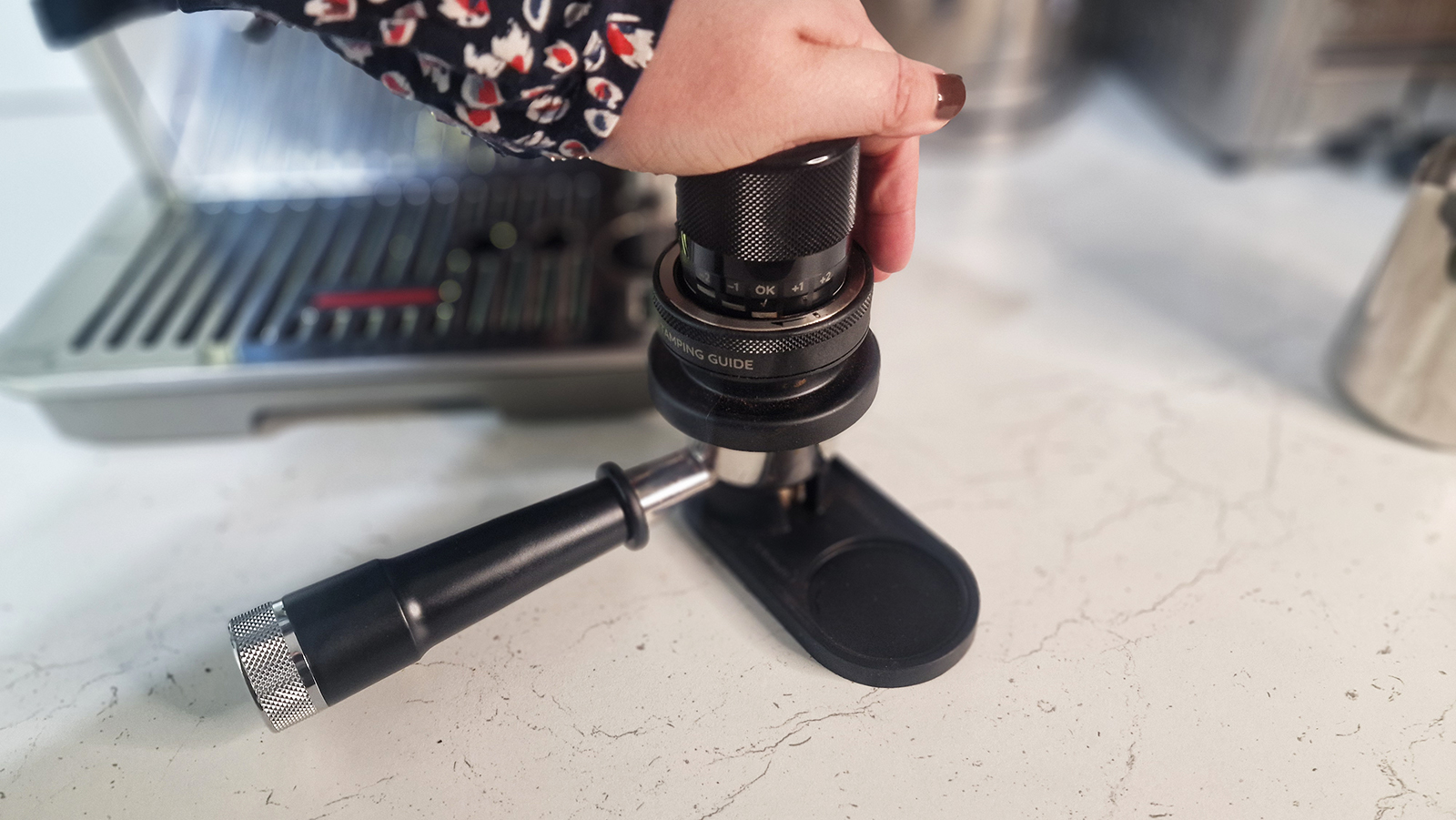
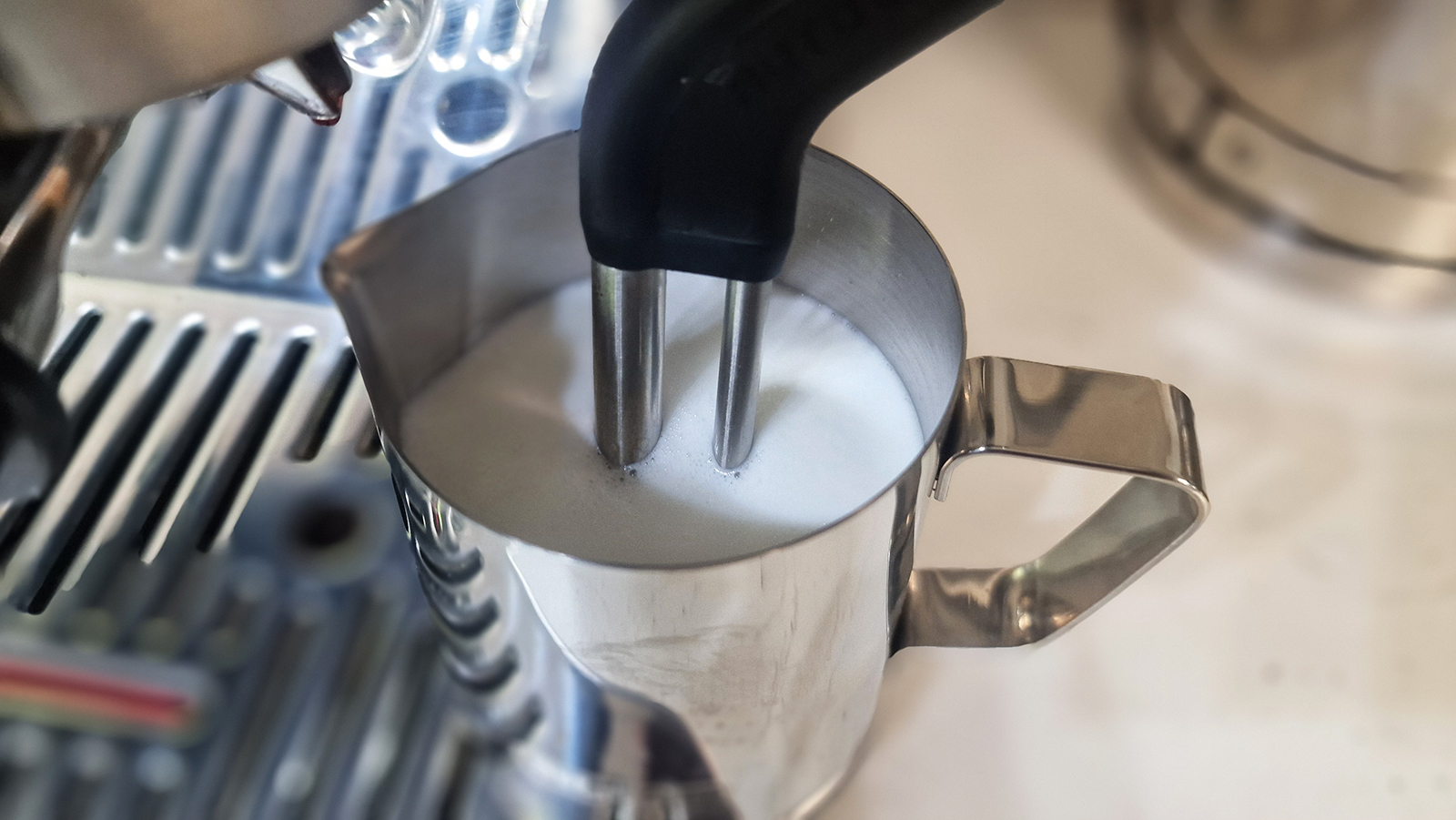
Specifications
Reasons to buy
Reasons to avoid
If I was starting from scratch in my small kitchen, this is the machine I'd buy. The De'Longhi La Specialista Touch is strikingly compact and well-priced, but it doesn't skip out on smart features. Striking an ideal balance between user-friendly design and elevated touches, the La Specialista Touch walks you through every part of the brewing process with its responsive 3.5-inch touchscreen.
You can steam milk manually or use automatic features which this machine, which is a welcome feature that brings it into line with much more expensive options from the likes of Breville. In terms of cost, while it's an investment, I think the La Specialista Touch offers outstanding value.
It's fun to make espresso from scratch, but grinding, tamping and brewing can be a messy business. The La Specialista Touch doesn't have an in-built tamping arm, but it does include a tamping kit which allows you to check the volume of your grind and evenly compress it into a puck. The screw-on funnel helps keep things mess-free.
The full review
Grinder
The La Specialista Touch is super interactive, starting at the bean grinding settings. It uses De'Longhi's "Bean Adapt" tech, which walks you through the grinding process by asking you about the type of beans you're grinding and the color, which can indicate the roast level. Based on that, it asks you to set your grinder to a specific number, and then asks you to use the smart tamper to tell the machine the amount of coffee it needs to grind to get the perfect level.
Following all of that, the machine then tells you to increase of decrease grind size depending on how long the extraction takes. Combine all those factors, and it tackles the cause of most bad espressos right from the start.
You can choose from 15 coarseness settings, which is pretty average for machines of this spec and price. It was capable of finely grinding light-roast beans, and there's plenty of scope to increase the grind size for darker roasts.
Espresso
I made some yummy espresso with the La Specialista Touch. It allows you to save bean settings to shortcut the Bean Adapt process, and I was able to flip between my go-to Lost Sheep Get To The Hopper beans and some cheap Aldi beans with ease.
When using great beans, the machine delivered a rich brew with notes of toffee and chocolate. It was the ultimate base for a latte or cappuccino, and if I was making an americano, I could leave my cup in place for the machine to top it up with hot water using a dispenser located right next to the group head.
I should also note that this machine makes cold brew, which is an increasingly popular feature in more modern machines. My brew was light, fruity, and balanced, but you should note that it doesn't brew cold espresso.
Milk
You can steam milk both manually and automatically with this machine, but I have a preference for manual steaming. Its included (useful) temperature gauge prevents your milk from burning, but it also gets in the way a little when hand-steaming. I got used to it, but it was a minor annoyance at first.
As for the automatic milk steaming, this was among some of the best I've tried. If I'm being picky, this is a feature I think Breville machines dominae, but the La Specialista Touch did make some fantastic latte milk which poured well with some swirling. My cappuccino foam was light and a little dry, which made a great topper to a shot of rich espresso. De'Longhi La Specialista Touch
Read our full De'Longhi La Specialista Touch review
Best compact espresso machine
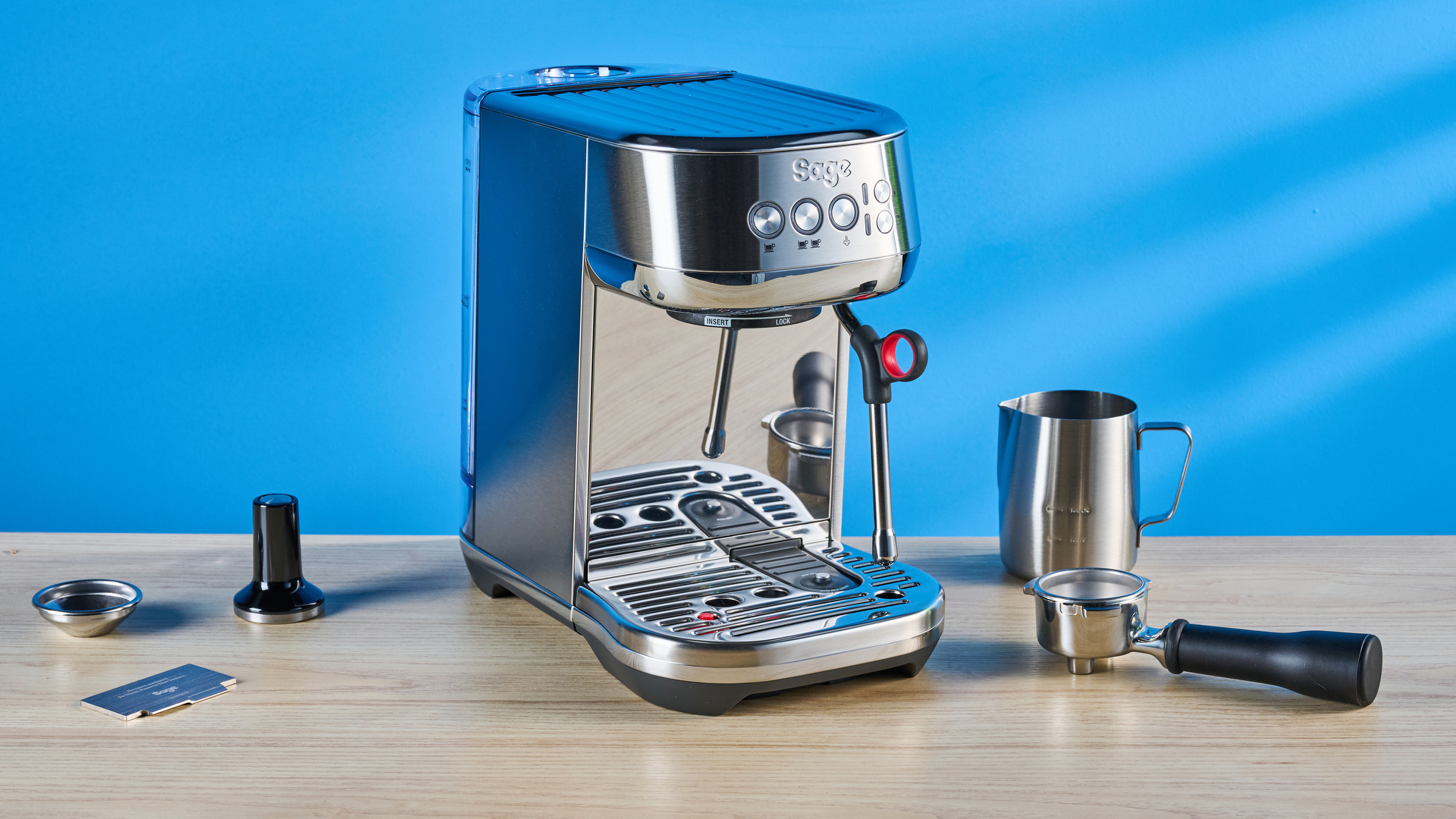

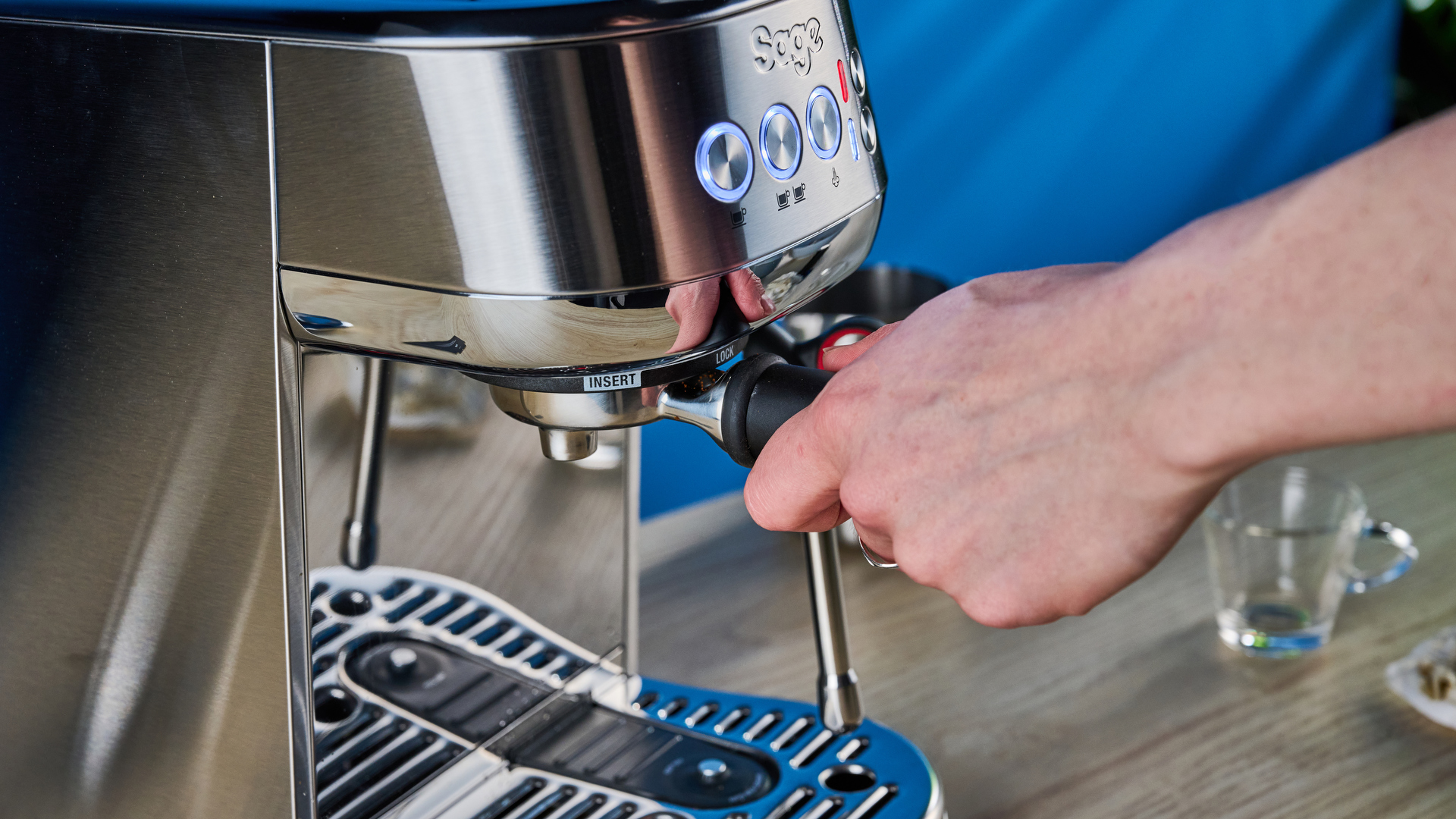
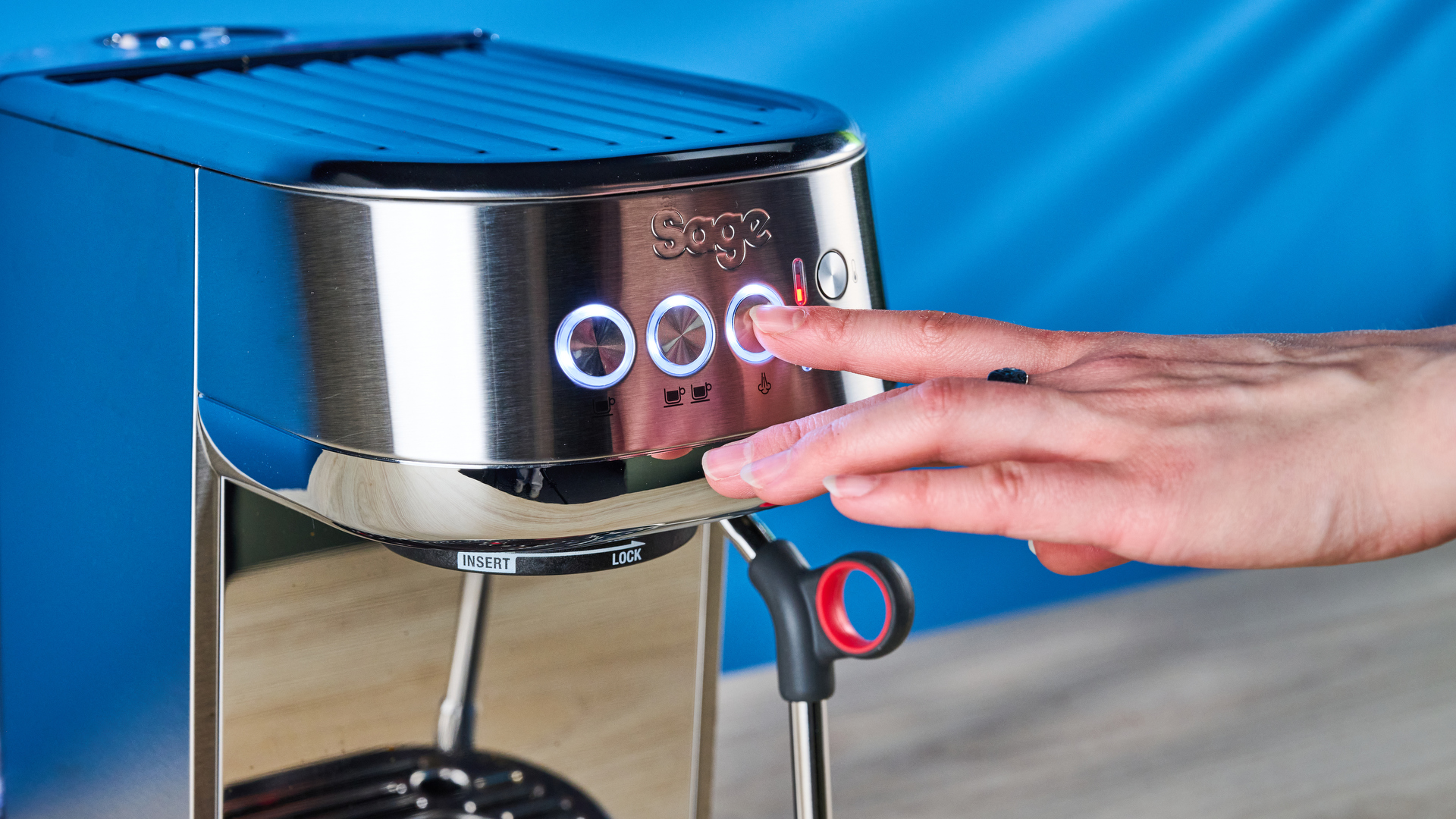

Specifications
Reasons to buy
Reasons to avoid
The Sage / Breville Bambino Plus is an iconic option from one of the most famous coffee brand you'll definitely have heard of. This is the machine I should've bought when I first invested in an espresso machine. Think of it as a blank slate. It could keep a coffee fanatic more than satisfied, but because of its assisted features, it won't let newbie brewers down.
Espresso machines can be chunky, so this is a rare compact option that will sit streamlined in just about any space. It's one of the few options in this guide that doesn't include a grinder, so you'll have to use pre-ground coffee or purchase your own grinder (check out our reviews of the best coffee grinders for some options, but they don't have to be expensive!) to use it.
What really sets this machine apart is its automatic milk steaming. You can choose between 3 foam and 3 temperature settings to achieve your ideal consistency, and leave your wand to do all the hard work with surprisingly brilliant results. But if you did want to learn how to steam milk manually? This machine will let you do that, too. It offers assistance without restriction, making it deal for beginners.
The full review
Grinder
This machine doesn't have a grinder, but it's worth digging into why that's not a bad thing. For a start, some enthusiasts prefer to buy separate grinders and espresso machines as it allows them to switch up their setup more easily, and if something breaks, you won't have to replace your entire coffee setup.
The machine comes with single-walled and double-walled baskets. If you plan on using pre-ground coffee, I'd suggest starting with double-walled, as they can bring back some of the fresh and lively flavor you'll be missing from fresh-ground coffee.
Espresso
The Breville Bambino Plus produces very high-quality espresso without taking up too much counter space. Breville (or Sage, for European readers) is famed for making market-leading machines, and while this is one of the brand's entry-level options it doesn't miss out on premium-feeling features or the powerful extraction you'll need to get a great shot.
There's pre-infusion, which will soak your puck to allow flavors to develop before extracting your shot, and there's also volumetric dispensing to pour either a single or double completely hands-free.
One downside is that there's no hot water dispenser, so if you like Americano coffee you'll have to keep a kettle on-hand to top up your shot.
Milk
Steaming milk is really tricky when you're just getting started, so the Bambino Plus' MilQ Plus setting will be a welcome option for those who want hands-free milk steaming. This allows you to choose from three pre-set temperatures and textures, then leave your milk to be steamed automatically. The best bit? You'll then get to pour it yourself, allowing you to practice your latte art.
If you would prefer to steam manually, that's also an option. I have a Breville machine at home which also features automatic steaming, and it's great for my partner who doesn't know (or care) about how to steam milk. However, the ability to still use the wand manually gives me more control and allows me to feel engaged in the brewing process. Again, it's another awesome feature for beginner brewers.
Read our full Breville / Sage Bambino Plus review
Best espresso machine under $150






Specifications
Reasons to buy
Reasons to avoid
If you're on a budget, the De'Longhi Stilosa will be a good starting point. Admittedly, you'll need some skill to get great espresso out of this machine. This is because it's manual, meaning there are very few assisted features to make life easier. However, if you're willing to put in the work, the good news is that this machine is more than capable of extracting quality espresso, especially if you pair it with a quality grinder.
Considering the very reasonable price point, it's not surprising that this machine is mostly made of cheap-feeling plastic. But the good news is that under the hood, there's a decent brewer that performs as well as much more expensive machines.
Most impressive was its quality milk wand, which was capable of achieving a fine micro-foam that made delicious lattes and flat whites.
The full review
Grinder
This machine doesn't have a grinder. It's not too hard to make a decent manual espresso machine on a budget, but including a quality grinder (which is absolutely a non-negotiable if you care about great coffee) is expensive. Market-leading grinders can easily cost $300+, so if your machine offers both grinding and brewing capabilities for less than that, it's likely that the grinder is poor quality.
So if you're on a budget and don't mind getting hands-on, the De'Longhi Stilosa is a good work around. Especially if you combine it with a quality hand-grinder like the sub-$100 1Zpresso Q Air.
Espresso
Tested by our reviews writer (and former barista) Erin, the De'Longhi Stilosa competed with some of the much more premium machines she's reviewed.
With a bit of experimentation and dedication, she found that there’s no reason why you can’t pull consistently delicious shots on the Stilosa. It does require a little know-how, but that's a classic trade-off for the price.
Because the machine doesn't brew to single or double shots, you need to monitor and switch it off yourself. For this, you'll be better off buying a coffee scale so you can tailor your ratios.
Milk
You might expect the steam wand on a cheap machine to be flimsy, but if anything, Erin found that the Stilosa’s steam wand can be a touch overzealous.
A former barista, Erin knows her way around a steam wand, and she found that this one needed full concentration during steaming to prevent the milk from becoming over-textured.
However, she did make some awesome lattes in the Stilosa. And for the price, it's one of the top steam wands she's tested.
Read our full De'Longhi Stilosa review.
Best espresso machine for beginners

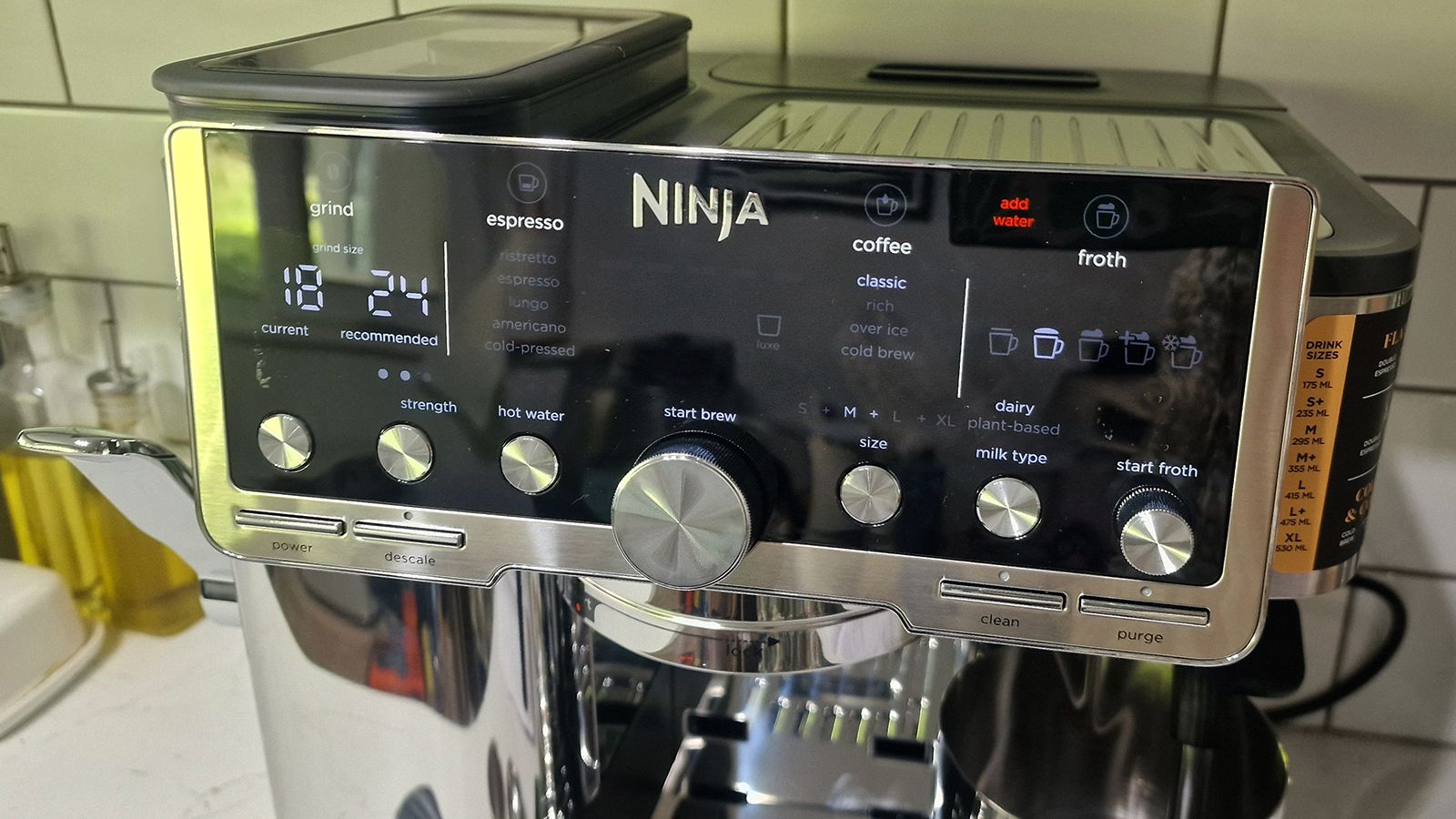
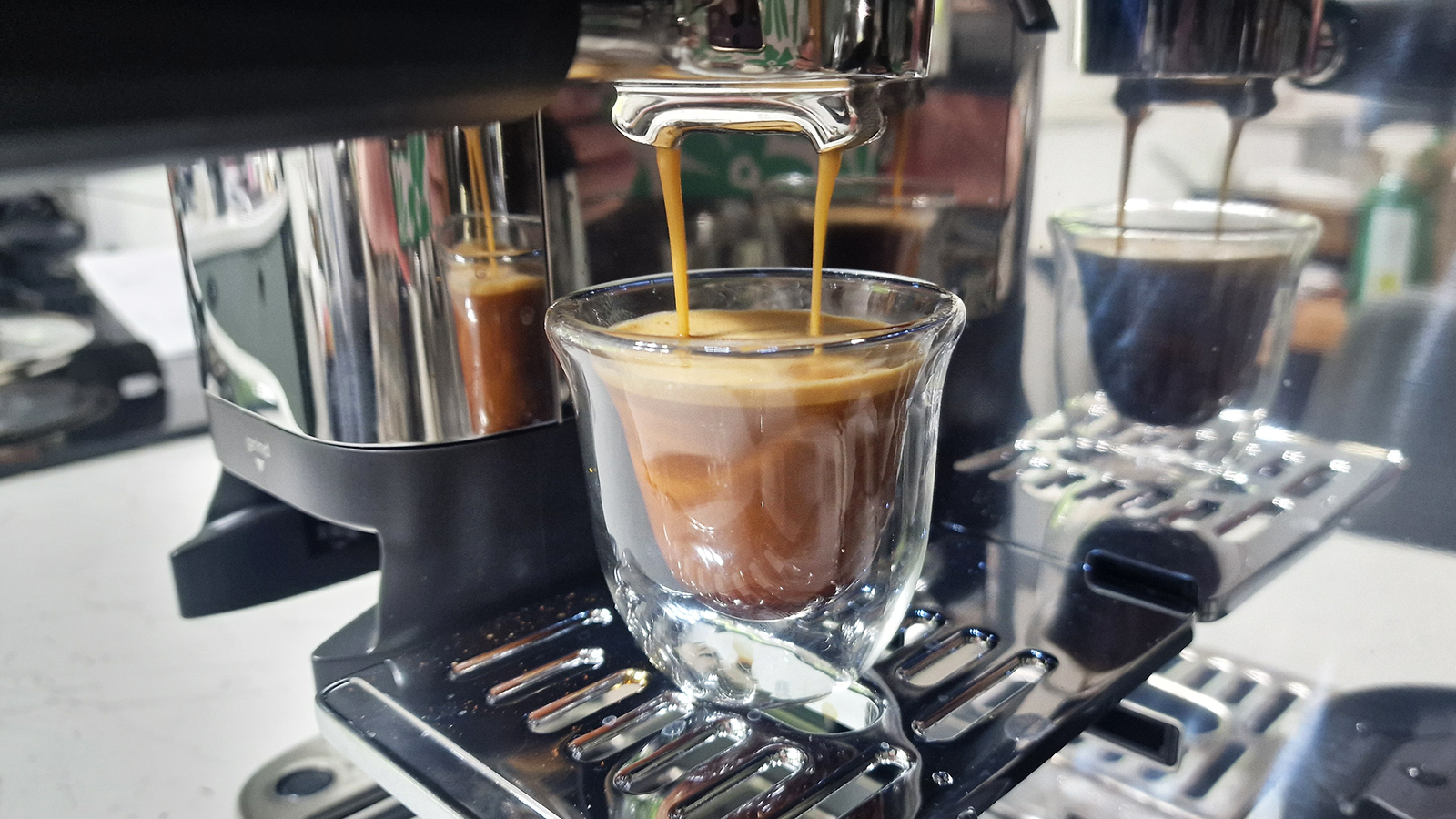
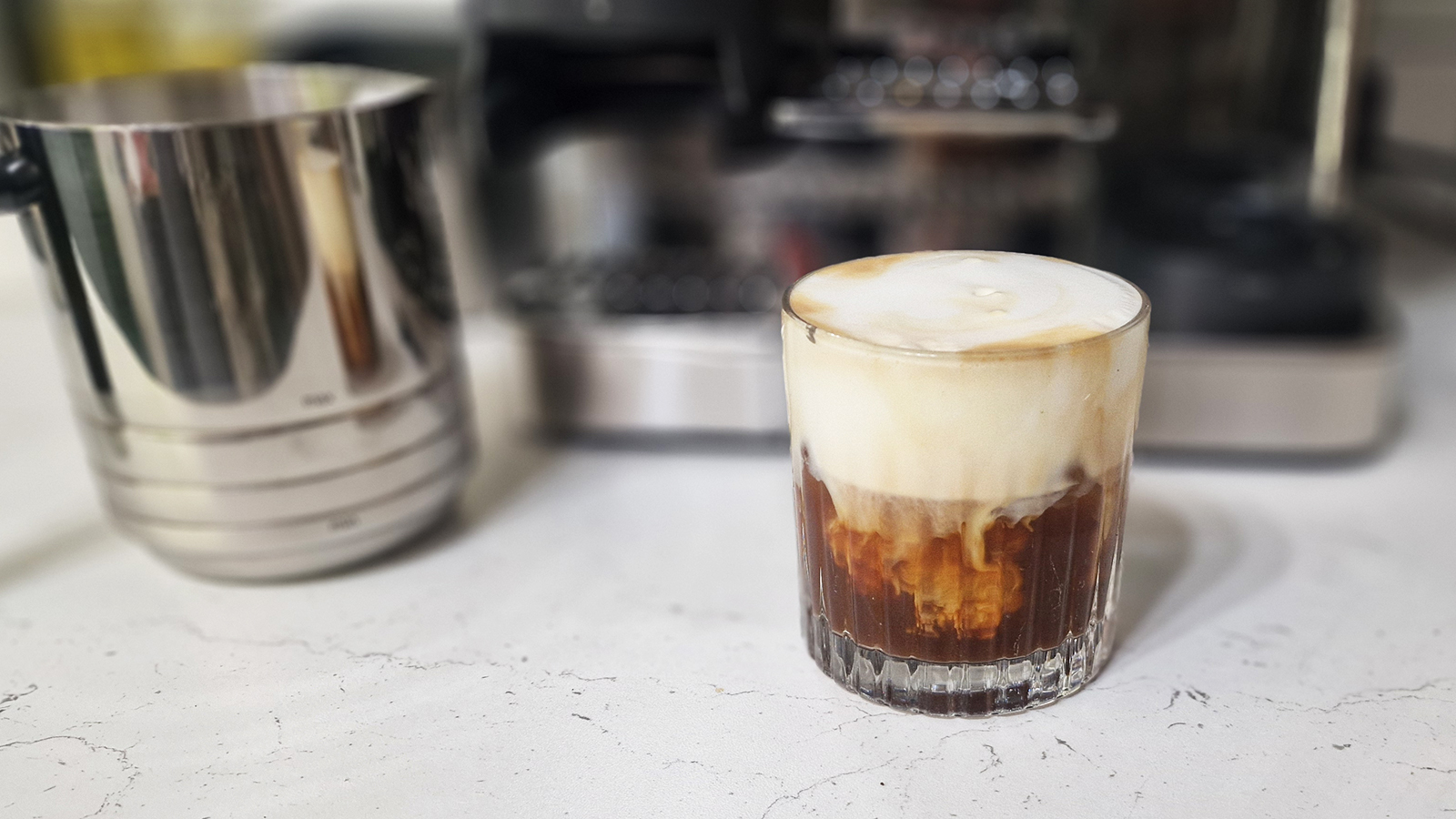

Specifications
Reasons to buy
Reasons to avoid
The Ninja Luxe Café Pro is a step up from the original Premier Series, which was only released last year. But it's an exciting release, and after testing it, I decided that it deserves to take the Premier's place in our best espresso machine guide. In my humble opinion, it's not a looker, but it's hard to deny that it delivers on performance.
The main addition to the Pro is its in-built tamping arm. This makes the machine totally mess-free, applying an even pressure across your puck for a level compression and balanced extraction.
One of the main advantages of this machine is its versatility. It can do espresso, drip, cold brew, hot water for tea, automatic steaming (with five foam levels) and cold foam for perfect iced lattes.
The full review
Grinder
The Ninja Luxe Café features a conical burr grinder with 25 grind sizes on offer. The machine makes everything from cold brew to drip coffee, and it's quite hard to get a great grinder that can offer the right size for all of those brews, but the Ninja just about manages it.
The grinder works on an unusual weight-based system. Most in-built grinders with assisted dosing will use a volume level on in-built tamping to indicate if you have enough grounds, so the Luxe Café's integrated weight dosing is something pretty new for the market.
The main step up from the originalis the in-built tamping arm, which makes the brewing process completely mess-free. The machine will suggest grind size changes depending on your extraction, but during testing, I found this feature a little hit-and-miss.
Espresso
The original Luxe Café came without a single shot basket, but this new version features one, alongside the double and quad-shot baskets. It automatically detects which basket you're using and adjusts its grind volume accordingly, which is a feature I love.
There was a little trial and error required to get the perfect espresso with this machine, but once I had the ideal grind size, I was off to the races. It makes great coffee. My espresso flowed in thick and creamy ropes, my drip coffee was dark and strong, and my cold brew had a lighter texture.
One qualm is that this machine gives off a lot of waste water. I needed to empty the water tank on a very regular basis. This is partly because the area under the group head is removable to allow you to fit a travel coffee cup directly underneath, which is a nice touch.
Milk
There are some pros and cons to the milk steaming with the Ninja Luxe Café Premier Series. The milk jug has an in-built spinner to create a vortex in the jug when you're using the automated steaming mode, but you can use the wand manually if you want to learn how to steam by hand.
A big bonus for those who drink a range of milk types is that if you opt for pre-set milk steaming, you can switch between plant and dairy milk settings to prevent oat or soy milk from burning.
This is a halfway house between traditional milk steaming and using a handheld frother to create artificial bubbles in your coffee. Personally, I prefer the automated steam wands you'll find on Breville machines like the Bambino Plus.
But the in-built spinner does have one big bonus in allowing you to create cold foam to pair with your cold coffee. This is something I've not seen in any of the other espresso machines on the market.
Read our full Ninja Luxe Café Pro review
Best superautomatic espresso machine

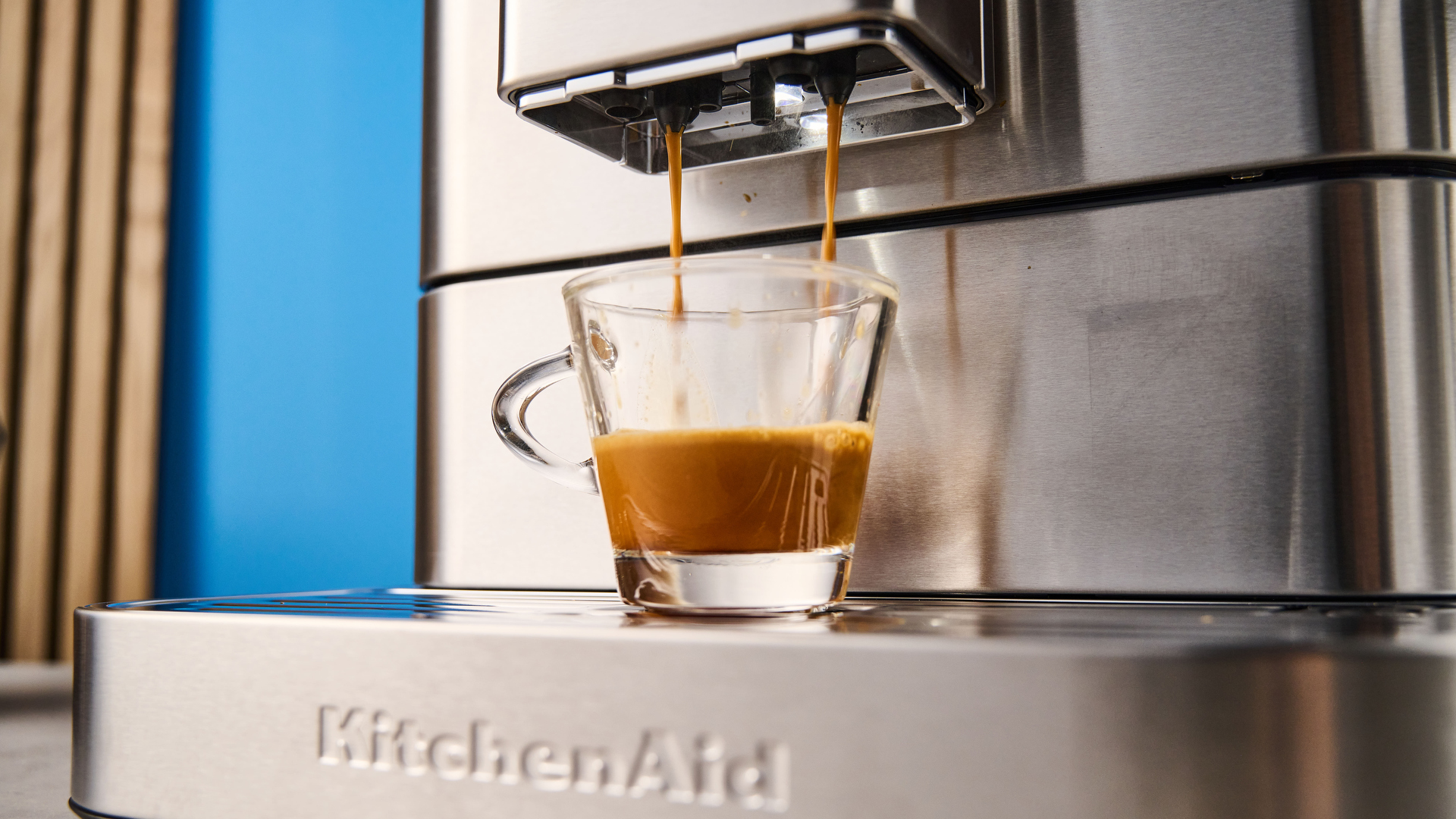
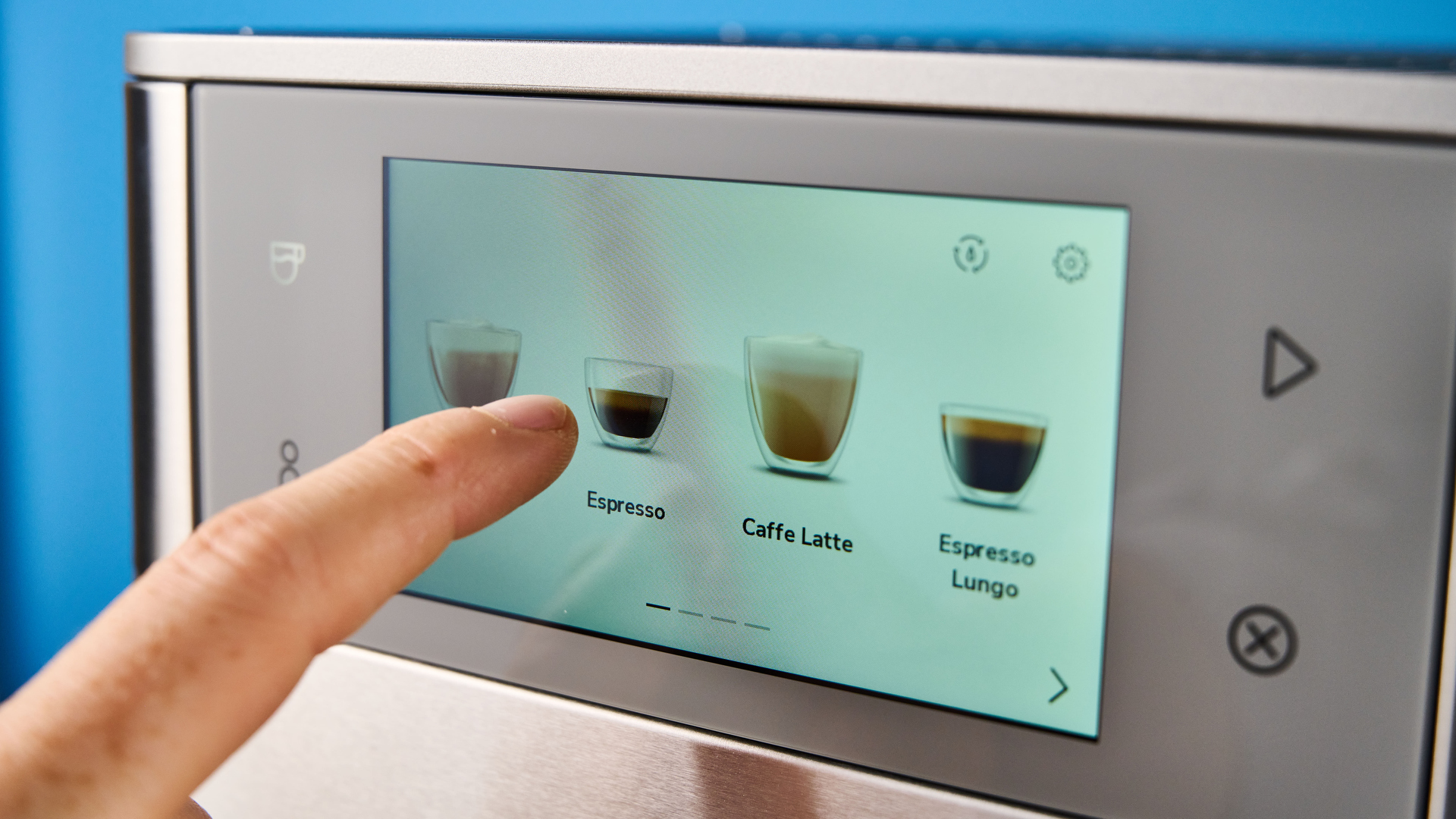

Specifications
Reasons to buy
Reasons to avoid
The KitchenAid KF8 was tested by Erin, our reviews writer who used to be a barista. Suffice to say, she likes getting hands-on with her brewing. But I recommend superautomatic coffee machines for people like my parents, who love coffee but really don't care about learning the ins and outs of how espresso machines work. And with a machine this capable, you really don't need to!
The KF8 allows you to select exactly what you want to drink and will set about grinding, tamping and brewing your shot completely automatically. It looks great, it's easy to use, it's able to keep up with busy families, and it allows you to fully customize your drink to get your exact preference, morning after morning.
The downside is that this machine, as with literally any machine that offers hot milk dispensing over milk steaming, won't rival hand-steamed milk. The mechanism of dispensing frothed milk from a tube simply can't replicate the process, which is something to be aware of if you really love your lattes.
The full review
Grinder
With the built-in burr grinder’s automatic dosage, tamping, and extraction, you really don’t need to do anything to get a steaming cup of coffee.
The grinder has 11 settings, which isn't great compared to alternative machines such as the Breville Barista Express. However, it's a great quality conical steel burr that KitchenAid could easily have got away with not including, considering you can't even see it in action!
Of the 11 settings we stuck to the finer end, making the most delicious drinks on setting 2. While this was very capable, it doesn't offer a huge amount of wiggle room if you wanted to go even finer.
Espresso
The KF8 is, without a doubt, the easiest way to make coffee. All you have to do is click a button and the machine makes delicious lattes, cappuccinos, and more in seconds.
With the built-in burr grinder’s automatic dosage, tamping, and extraction, you really don’t need to do anything to get a steaming cup of coffee. Erin found that the espresso was "juicy and evenly extracted after a fully automated brew cycle."
The best part? If it doesn't taste good, the list of things that you might need to change is very short. It's either down to your beans or your grind size, because everything else that could throw off your shot is automated and out of the realm of human error.
Milk
The detachable milk frother automatically steams your milk, although Erin found this to be the machine’s weakest link, although having tested a number of machines like this one, I can attest that it's an issue you'll run into with any superautomatic coffee maker.
In removing steam wands and instead pushing your milk through a tube to heat and texture it, it's not so much steamed as frothed. The result can still be very close to the sort of coffee you'd buy from the likes of a chain coffee shop, but there's no silky microfoam or latte art tulips here.
Read our full KitchenAid KF8 review
Best premium espresso machine
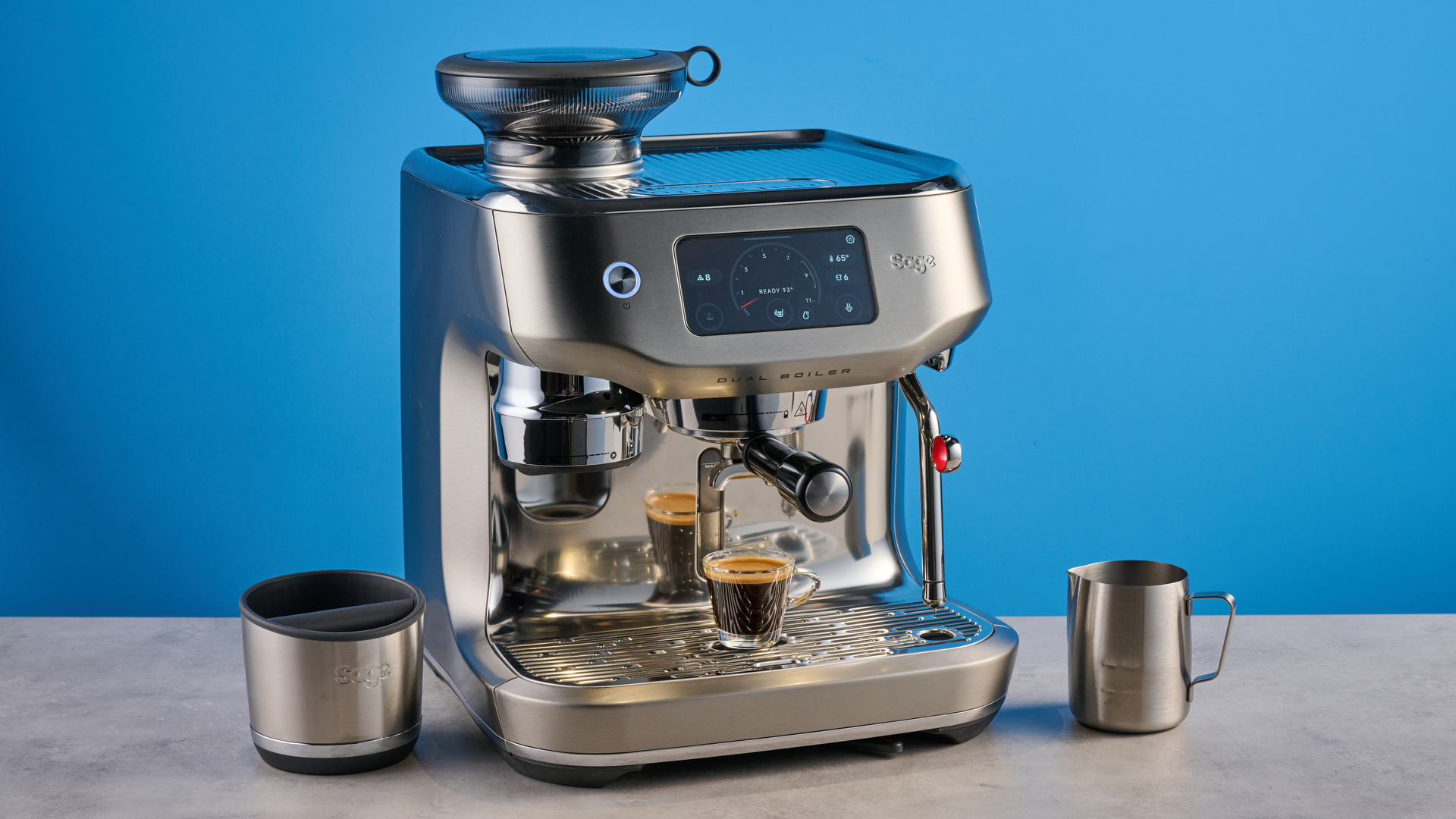
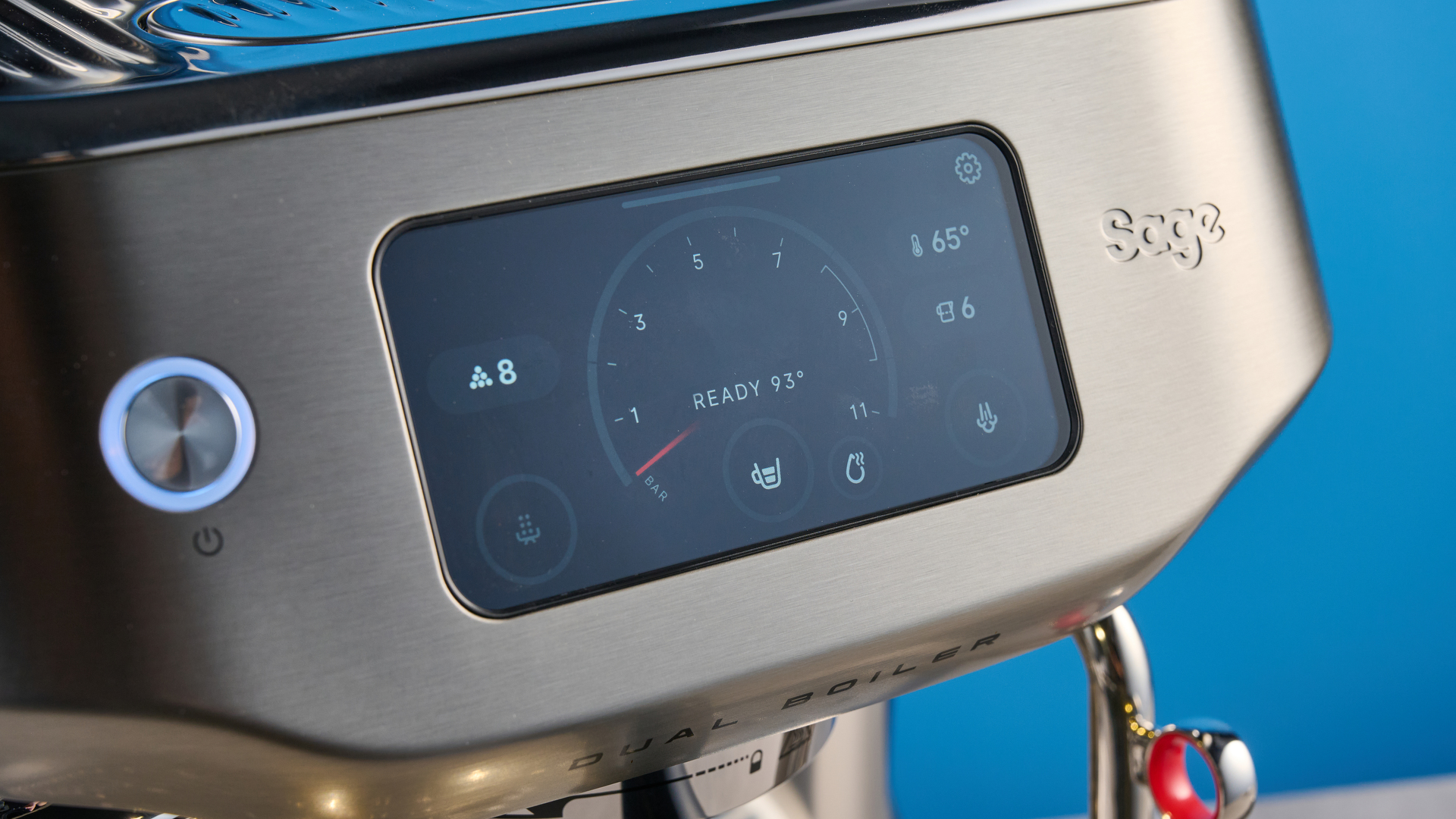
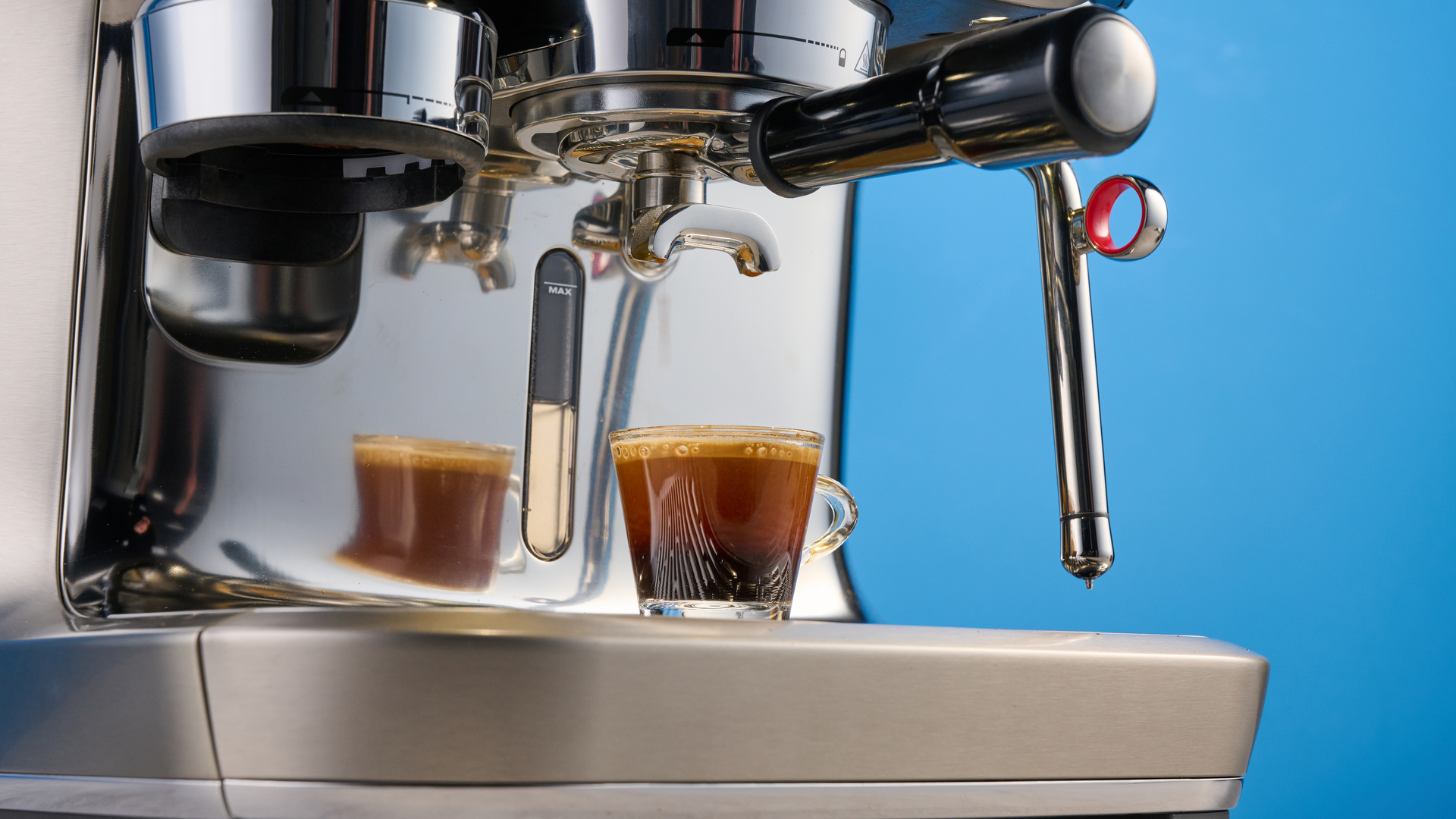


Specifications
Reasons to buy
Reasons to avoid
The latest release in Breville's premium Oracle line, the Dual Boiler is an option for serious coffee fanatics. But it's also accessible, with a mix of manual and automatic features that will suit a range of skill levels.
With the Oracle Dual Boiler, you're getting a supercomputer and a coffee machine combined. It features a highly interactive touchscreen and quadcore processor, which allows you to switch between manual and automatic settings. Opt for automatic, and you'll be guided through a huge assortment of coffee recipes with clear instructions for each. Opt for manual, and you can go solo.
Be warned though, because this machine not only expensive, it's also massive. It's got to be, because it has a dual boiler design that allows you to brew and steam simultaneously. Coffee fanatics often favor dual-boiler coffee makers, which offer a more efficient workstream and higher temperature stability and control.
The full review
Grinder
The only real fault this machine has is its grinder, which is a Baratza Encore ESP. That's a very well-respected brand, but from what we could tell, it's the same quality grinder you'll get in one of Breville's much lower-priced machines. We'd have liked to see an uplift in grind quality to match the excellent brewing and steaming settings on offer.
We managed to get some excellent espresso when brewing with deeper roasts, but on the lighter end, we found the Oracle Dual Boiler struggled to get the best out of our beans. The majority of coffee drinkers favor dark roasts, so this won't be a problem for most users, but it's an indication that the grinder could be better.
Espresso
We made some seriously tasty espresso in the Breville Oracle Dual Boiler. Like I said, it performed better with dark roasted beans. But we tasted strong chocolate notes and found our shots to be smooth-bodied and full of flavor. Ideal for drinking in a latte or cappuccino.
What's more, this machine will walk you through the brewing process from start to finish. What that means in practice is it will tell you if your shot didn't extract correctly, and troubleshoot it. That's great for people who are still learning about coffee and want a guaranteed good espresso.
Milk
No complaints here, the milk steaming with this thing is outstanding. It's got a super powerful wand on account of the dual boiler design, and we were able to replicate the sort of results we've experienced on professional-level steam wands.
Now, you can also opt for a manual steam with this machine, as you can with a number of Breville's more smart options. This will automatically texturize your milk for you, completely hands-free. It can't quite rival hand-steamed, but if you're not too skilled or you simply can't be bothered, it does a good job of mimicking the sort of steam you might get at a chain coffee shop.
Read our full Breville Oracle Dual Boiler review
Best espresso machine under $250

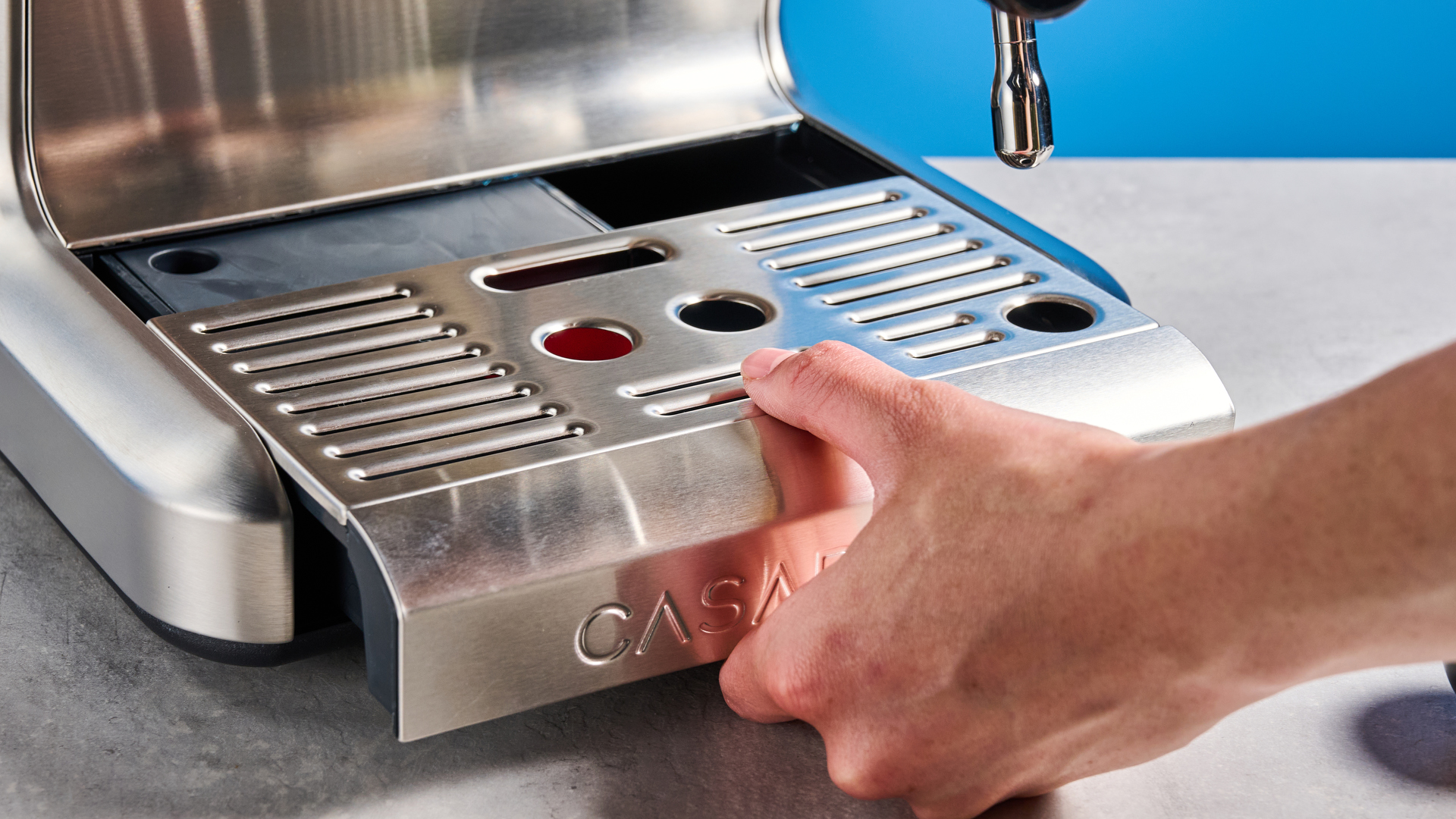
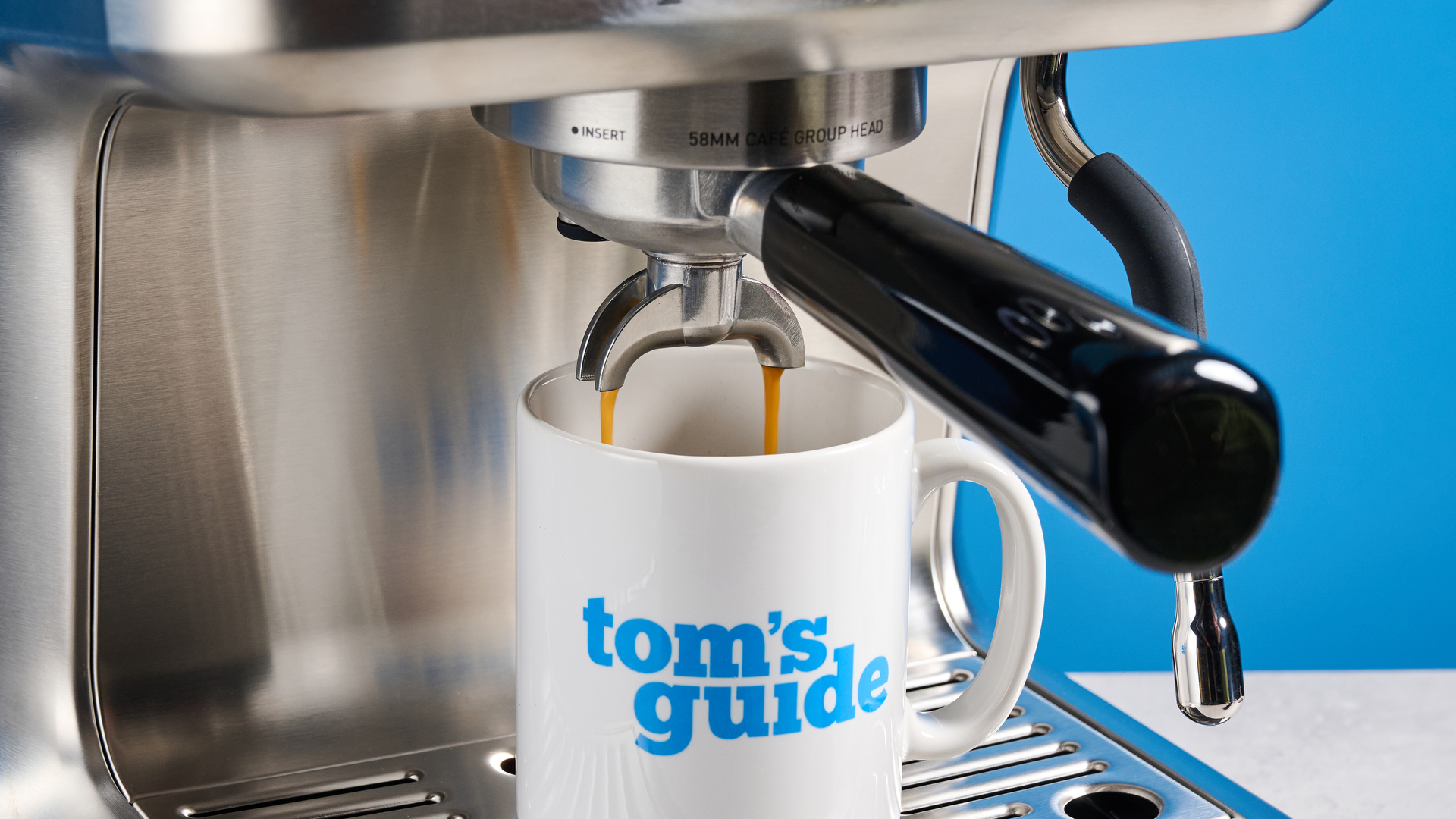
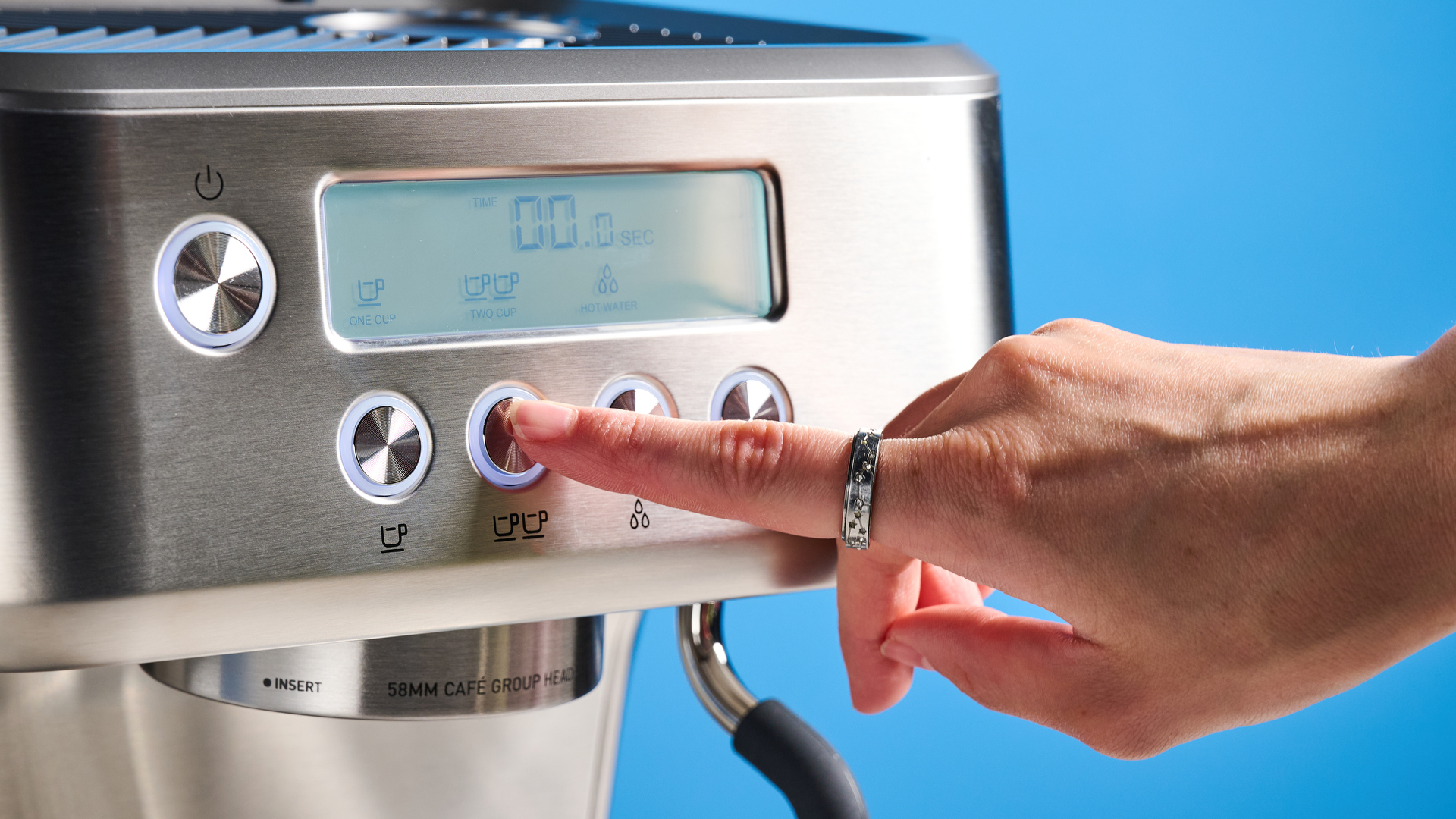

Specifications
Reasons to buy
Reasons to avoid
Casabrews isn't an established coffee brand, but if you go onto Amazon, you're guaranteed to find one of their machines, and it'll usually be on sale. We were a bit skeptical about these machines at first, and while you shouldn't expect such an affordable option to come without compromise, it does deliver an outstanding performance for the price.
One downside of the Ultra is the fact that its steam wand could be stronger. Our reviewer Erin thought it lacked the power of more premium models, as well as our top budget pick, the overenthusiastic De'Longhi Stilosa.
Looks-wise, I think you'd be hard pressed to complain with this machine on your counters. With a stainless steel exterior and an LCD screen, it certainly looks like a machine that's twice the price.
The full review
Grinder
Again, this machine lacks a grinder. But for the price, I don't think you'll be able to find an espresso machine with a decent integrated grinder anyway. You can pick up hand grinders for under $100 which will measure up nicely, and deliver fresh-ground espresso-ready beans.
Espresso
For the price, you get some nice touches with the Casabrews Ultra. This includes the LED screen, which can customize your brewing temperature and even features a timer which can count your extraction time. This is a key metric that you can use to tell if your coffee is well-extracted, so it's great that this comes on board.
You can choose from a single or double shot, as well as hot water extraction. This means you can press a button and leave your coffee to brew automatically, unlike the Stilosa which needs to be turned on and off manually.
Erin took about four shots to tailor her brewing settings before she was able to strike gold. Her ideal coffee required a little intervention (but it's easy to do this on the LED screen) to lower the brew volume to around 40g. But if you use good, fresh-ground beans, you can hit bright and bold flavors that rival much more expensive espresso machines.
Milk
If you're looking for a machine to perfect your latte art, you might find the Ultra a little lacking in power. Erin was able to make some decent milk, but it was far from professional-level.
But for beginners, this is a perfectly adequate machine. Erin used both oat milk and cow milk when testing it, noting that she got some decent results from the oat milk, which is typically harder to steam.
Read our full Casabrews Ultra review
Best espresso machine for steaming milk
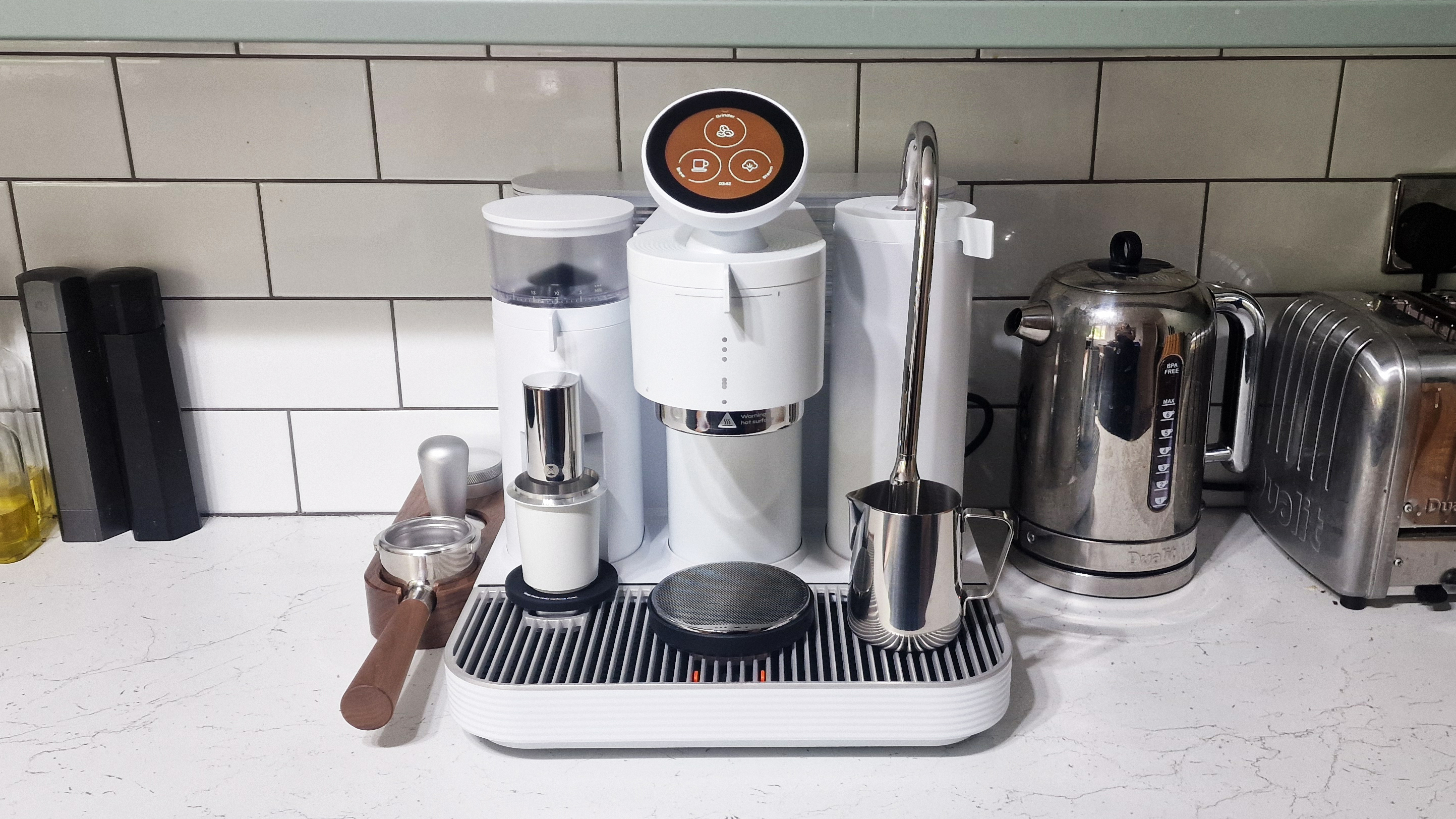

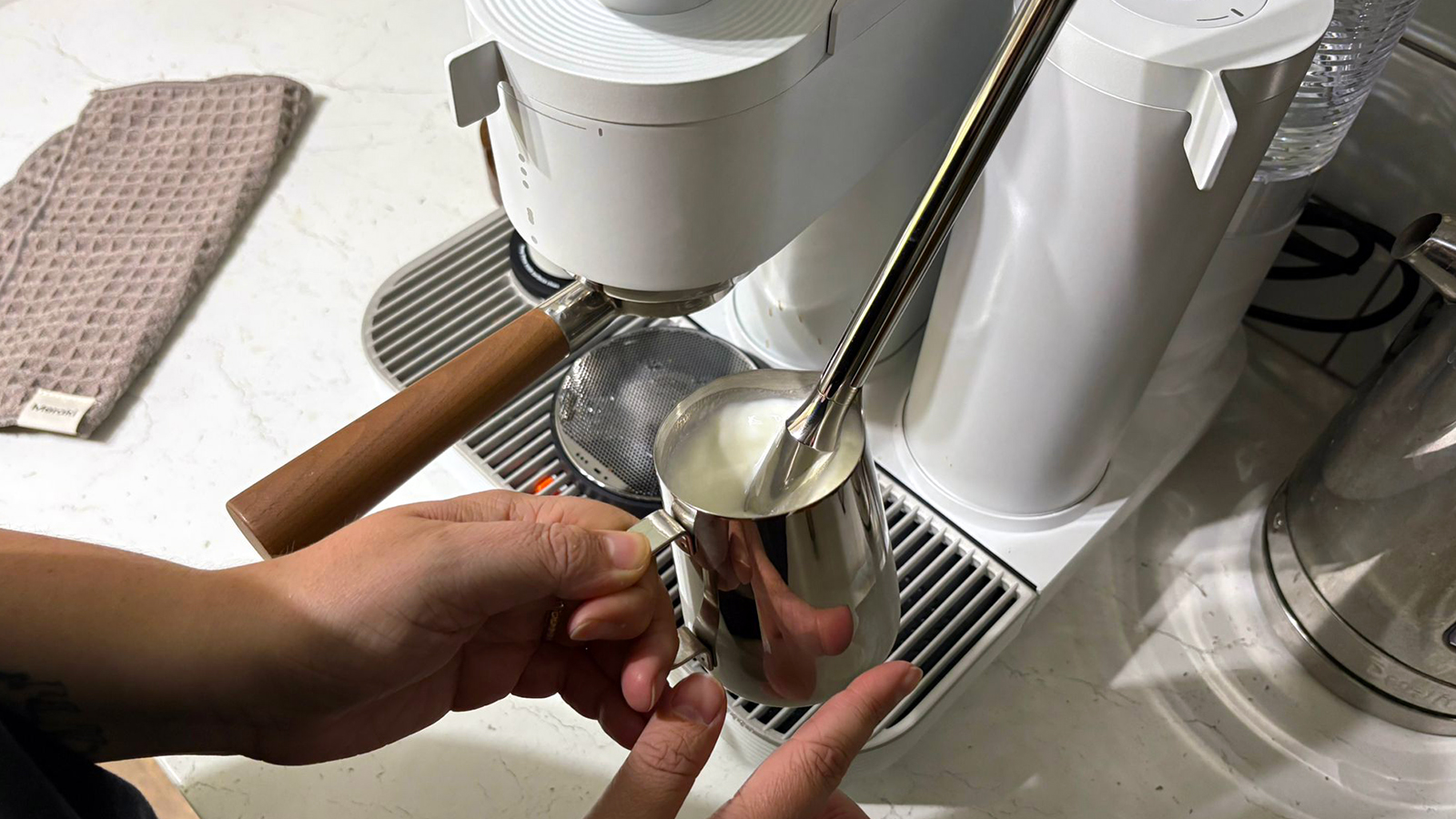
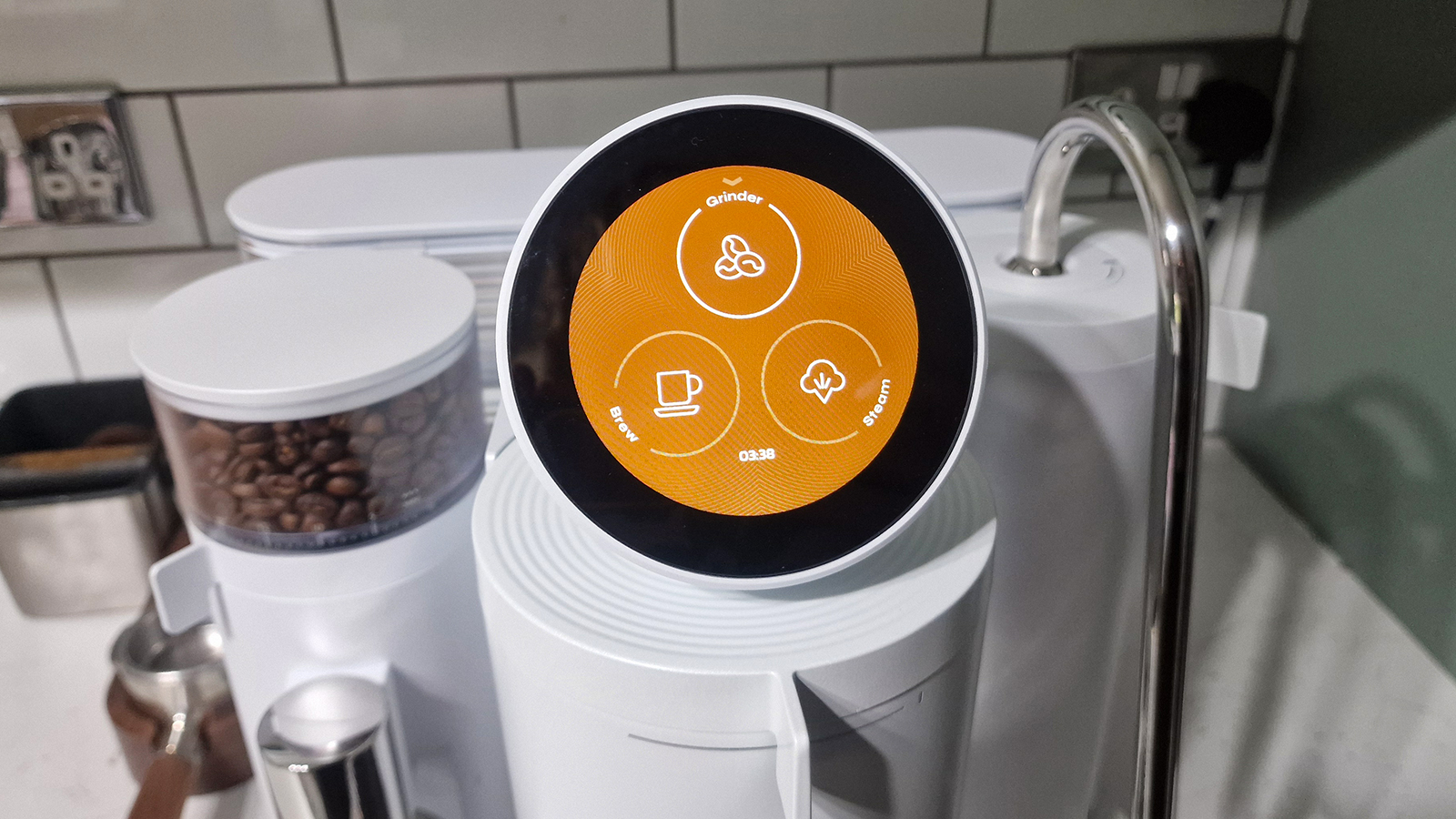

Specifications
Reasons to buy
Reasons to avoid
There's no espresso machine quite like the Meraki on the market. It's got a dual-boiler design, weighted grinding and brewing thanks to in-built scales and a powerful steam wand with an integrated thermometer. All for under $2,000.
I was curious to see if it could live up to those specs when I put it to the test, and let's just say I gave it a rave 4.5-star review. One of the best things about this machine is its super-powerful steam wand. You can toggle the intensity and watch your milk's temperature climb up in real time thanks to the smart display. And because it's a dual-boiler machine, you can do all this while brewing an espresso for your latte.
I've not tried such a powerful wand since I trained on a professional machine, which is a testament to just how impressive the Meraki is.
The full review
Grinder
The Meraki's grinder is made by TimeMore, a quality coffee grinder brand that sells standalone machines for $500. So it's impressive that Meraki has been able to integrate one of these into a $2,000, dual-boiler design.
You grind directly into a magnetic dosing cup, and the machine grinds by weight. Its hopper contains 125-grams of coffee, which isn't loads, but ideal for those who buy smaller bags of specialty coffee. And when I tested the machine, I found that it was capable of grinding super fine for extra dark roast beans, as well as lighter roasts.
Coffee
I made some astoundingly good coffee in the Meraki. It's got a bottomless portafilter, allowing you to watch your coffee brew in real-time, which is very satisfying. You again brew by weight, which can be pre-programmed or controlled manually.
You can also make use of an in-built hot water dispenser to top up espresso, ideal for Americanos (my go-to drink). My only real complaint is that the bottomless portafilter can get a bit splashy if you've got the wrong grind size. I chose the white colorway of the Meraki, and it requires cleaning pretty often.
Milk
The steam wand is a standout winner for this machine. It's the closest I've come to professional espresso machines since my barista training. It heats up fast, pulls a lot of pressure, and can create a velvety microfoam in under a minute.
The steam wand is fast and powerful, perfectly capable of creating the ideal microfoam. In fact, it's so powerful that I tend to use its medium strength setting for my lattes, as it buys me more time to texturize my milk perfectly.
Read our full Meraki Espresso Machine review.
Best stovetop espresso machine
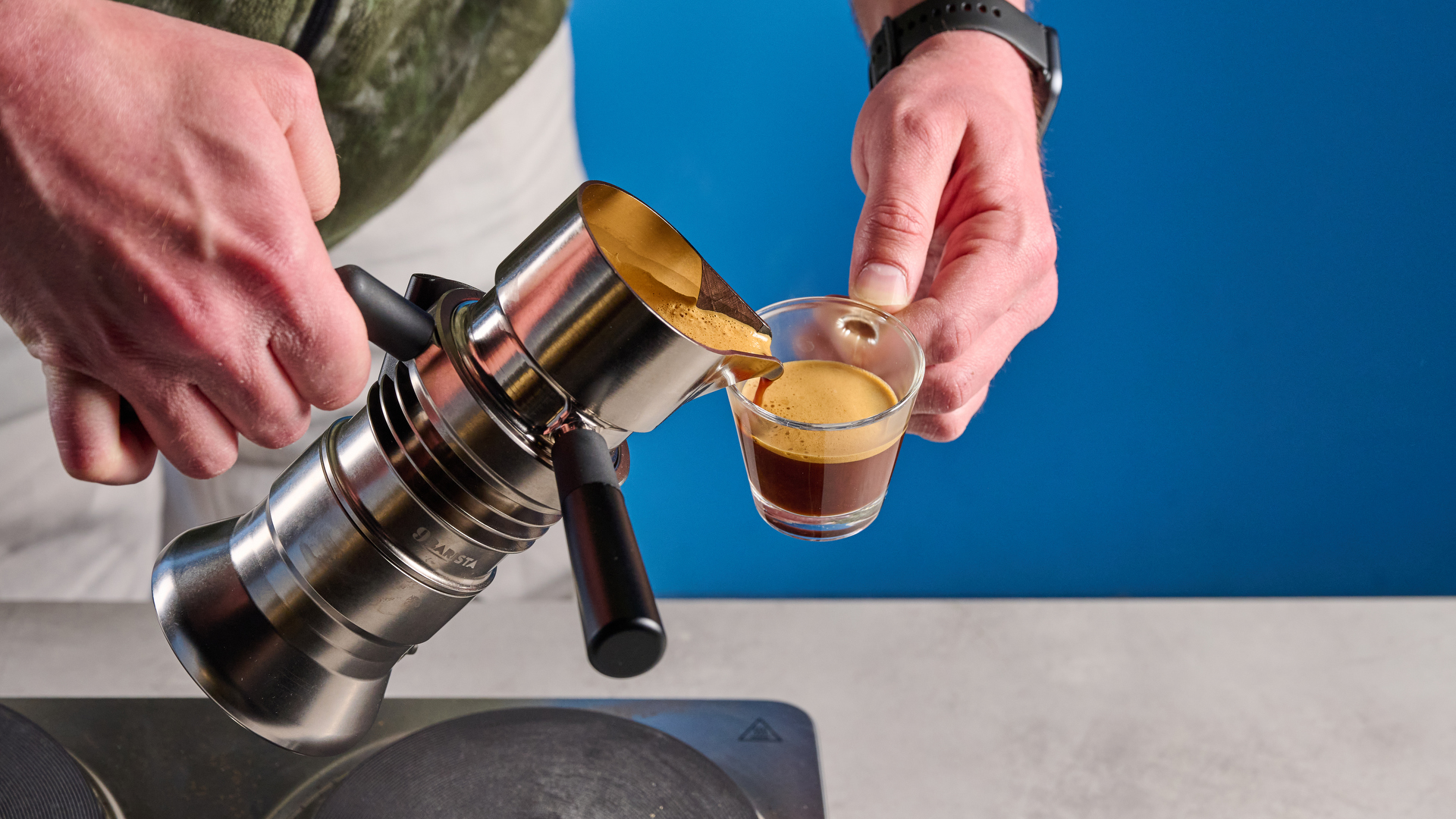
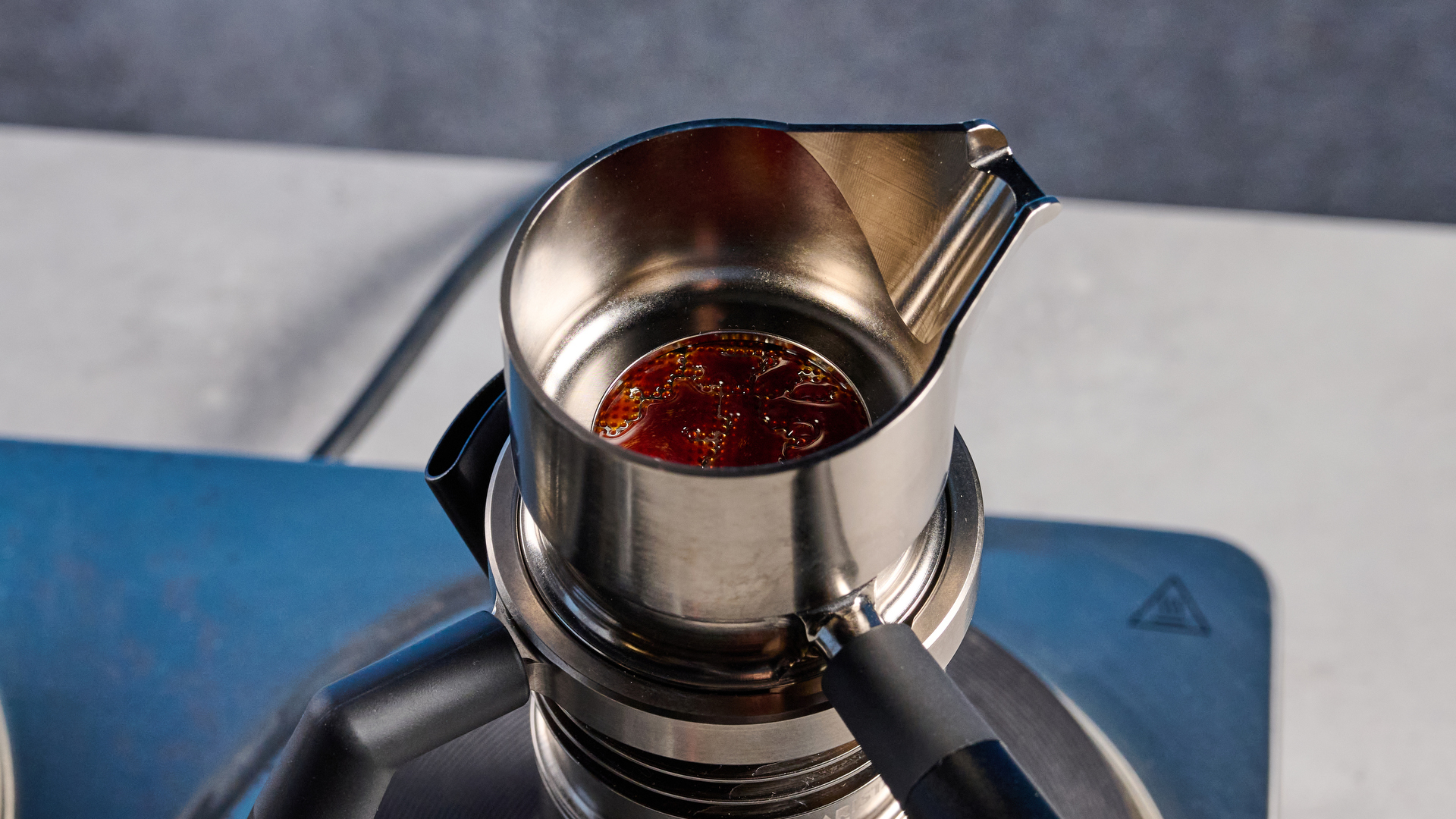
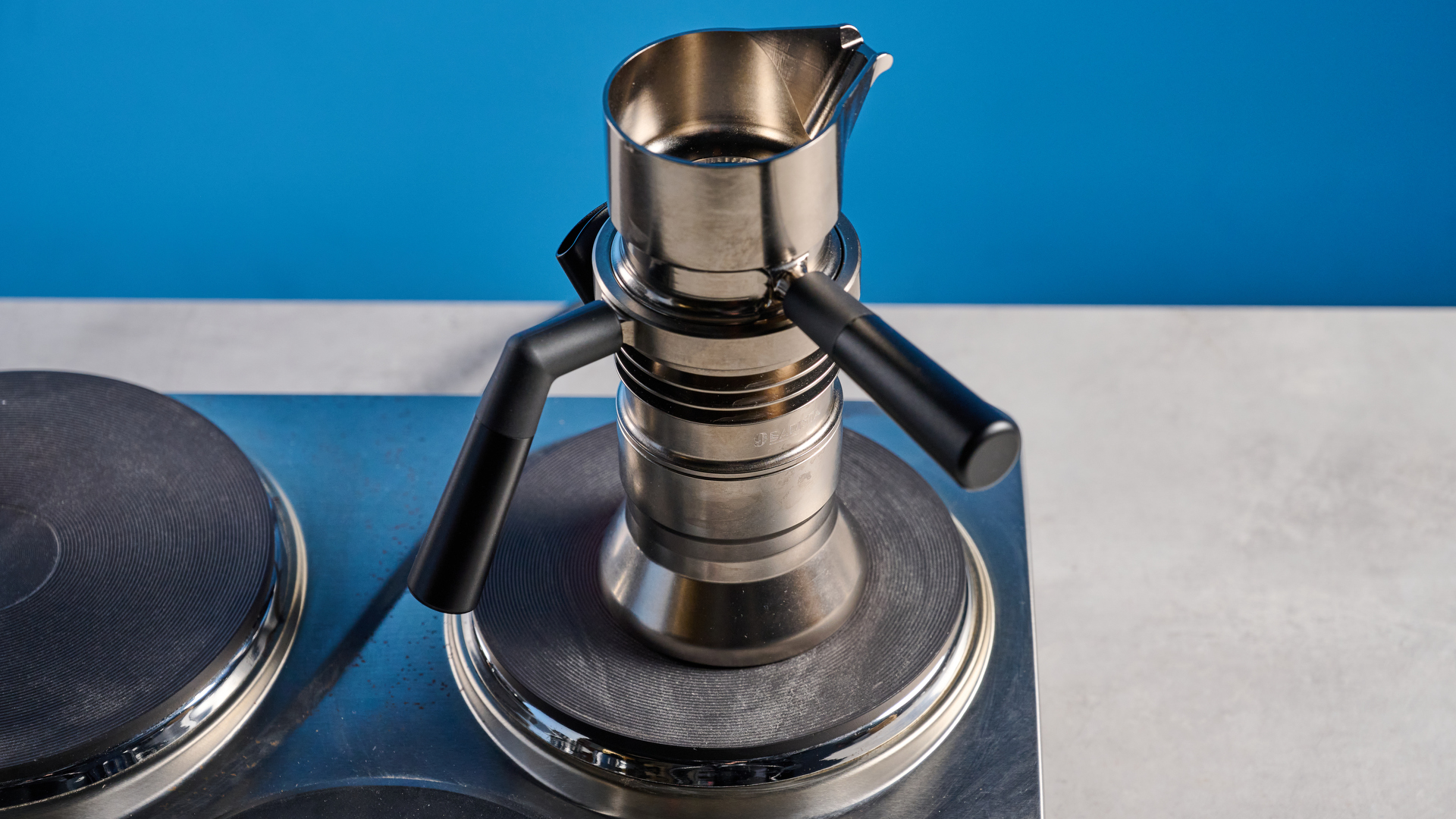
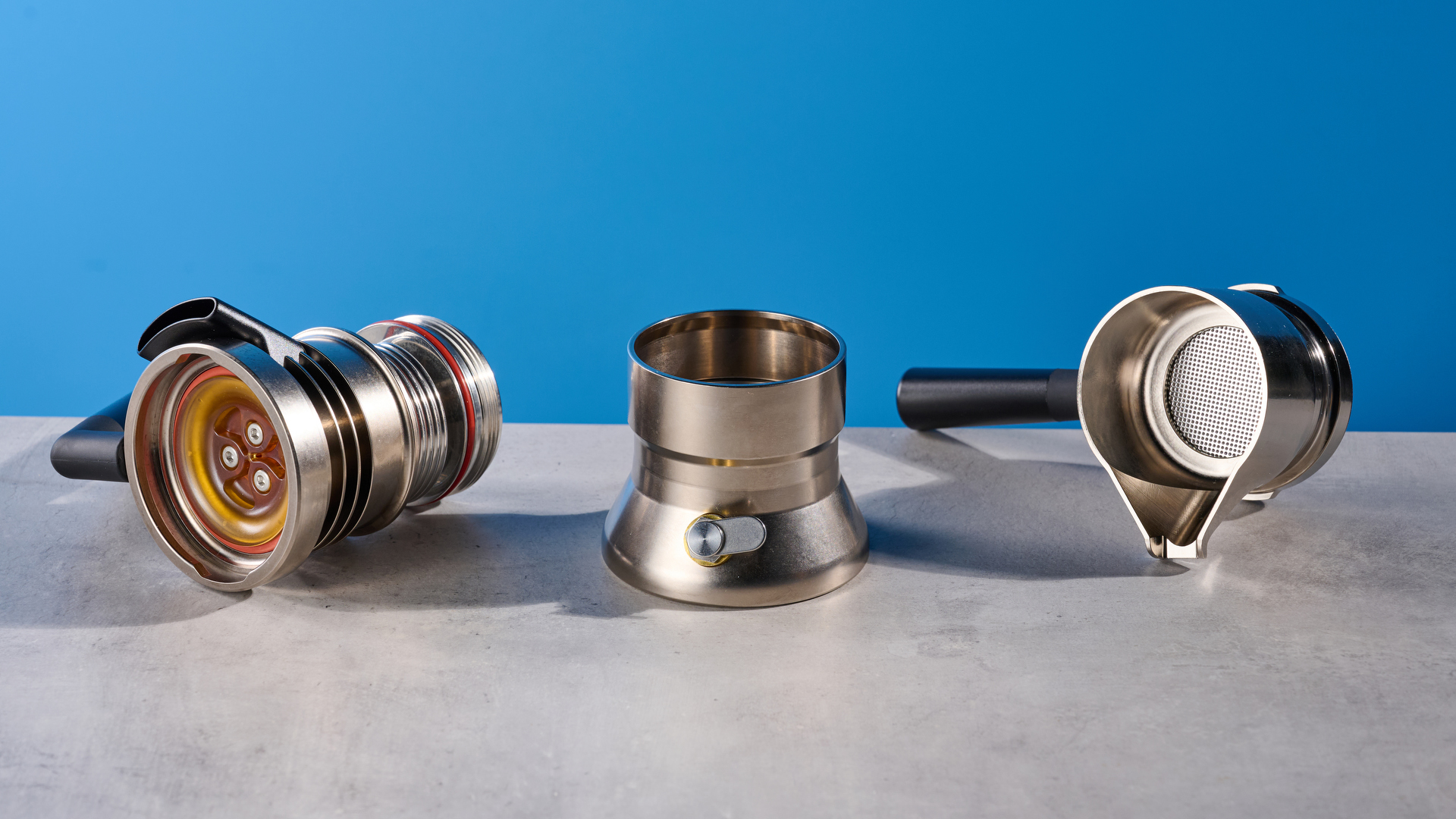

Specifications
Reasons to buy
Reasons to avoid
Naturally, most of the machines on this guide are, well, just that: machines. They’re mains-powered electrical appliances, with grinders, steam wands and lots of bells and whistles. The 9Barista Espresso Machine Mk.2 is a “machine”, but only in the Industrial Revolution sense of the word. The 9Barista is as analog as they come, but our reviews editor Pete Wolinski absolutely loved using it.
While this is a simple machine, that conversely makes it tricky to use as there’s nowhere to hide. It has none of the aids or assists of full espresso machines, and can be easy to get wrong. This machine isn’t for beginners, but enthusiasts who want a stripped back experience. It makes authentic, 9-bar espresso, and its simplicity lets you focus on controlling the fundamentals of espresso brewing.
This machine is suitable for travel, but it needs to be heated on a stove, so it’s only good for camping or visiting an Airbnb with a kitchen, for example. For travel, the Wacaco Picopresso is a better shout, as it takes hot water from any source, like a kettle.
The full review
Grinder
As a stovetop espresso maker, the 9Barista Espresso Machine Mk.2 has no grinder. We’d recommend a solid espresso-capable grinder to pair, such as the Eureka Mignon Specialita. Or, to match the stripped back, travel-friendly vibe, the 1Zpresso K-Ultra.
Espresso
The 9Barista Espresso Machine Mk.2 makes wonderful, authentic espresso. This isn’t just a moka pot cosplaying as a jet engine. The 9Barista is cleverly designed, with two water chambers and two sets of heat exchangers, this allows the water to get up to 9-bar pressure, and then be cooled to 93C without any pressure loss, before it hits your puck.
The result is legit espresso, which Pete adored in testing. Rich and complex, with thick crema. You don’t have any fancy controls like a PID or OPV (over pressure valve) to control temperature and pressure. You’re at 93C and 9-bar, always. And that’s liberating, as it takes you back to the core inputs: grind, dose and bean choice.
Milk
As you might’ve guessed by now, there’s no milk functionality with the 9Barista Espresso Machine Mk.2, so if you’re a fan of milk drinks you’ll want to check out a separate frother. The Subminimal Nanofoamer Pro Gen 2 is Pete’s recommendation.
Best for espresso enthusiasts


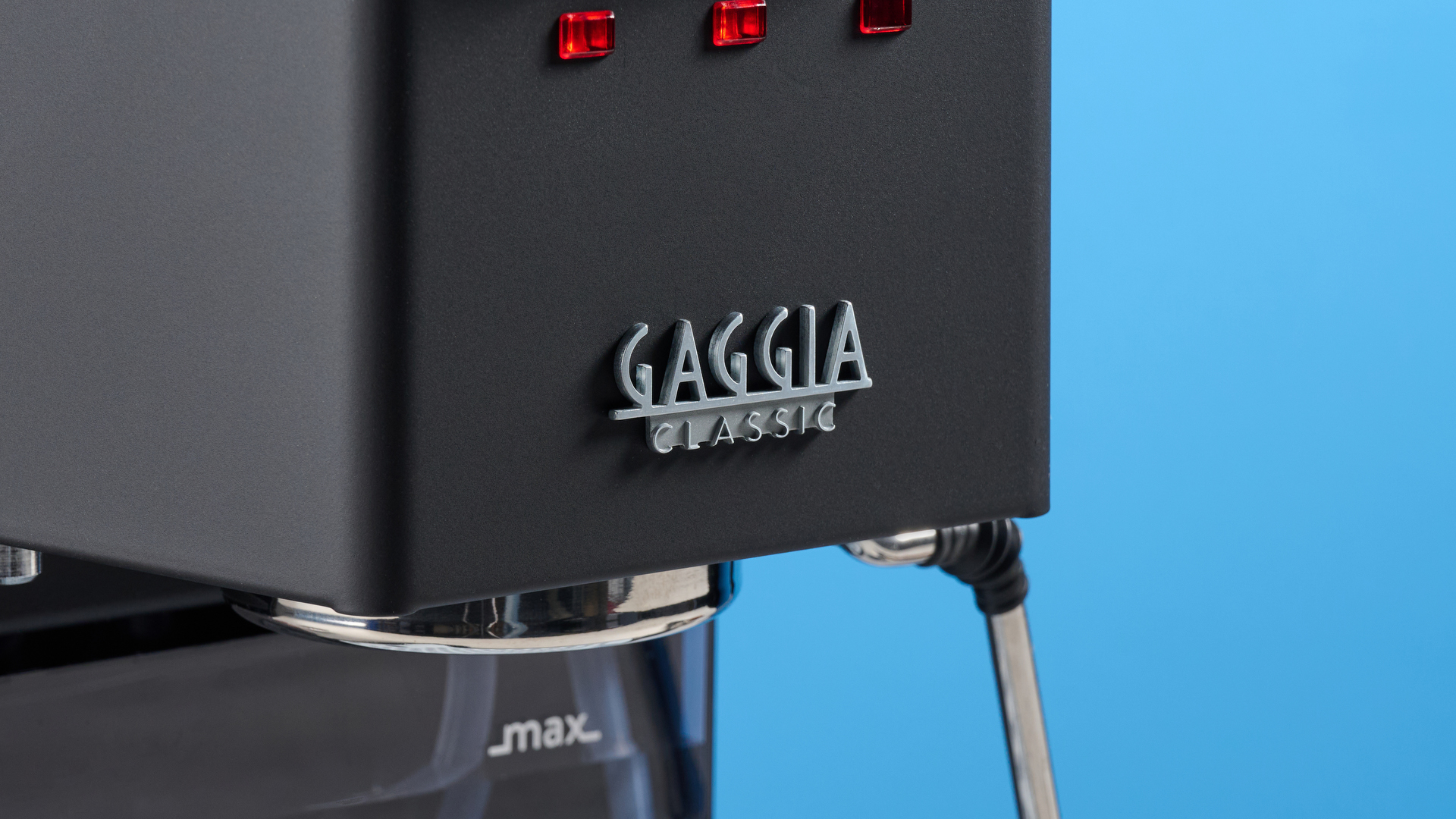
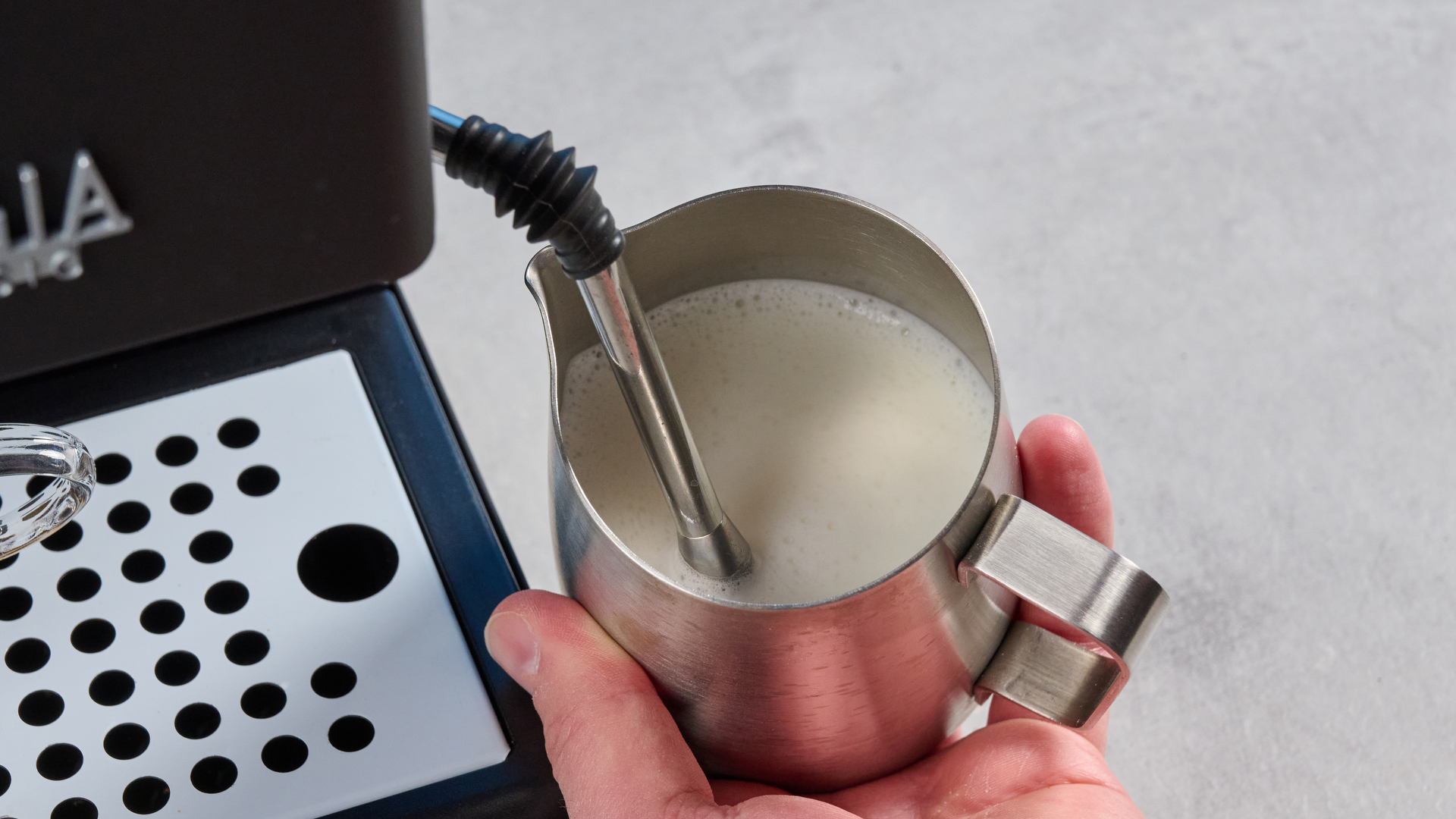
Specifications
Reasons to buy
Reasons to avoid
Most of this guide is geared towards the average home brewer, but if you want to take it to the next level, the Gaggia Classic E24 is our recommendation. It was tested by our Reviews Editor Peter, a former chef and serious coffee-lover who doesn't mind taking the time to craft coffee the old-fashioned way. His main gripe was that it came with poor-quality tools, but these are easily replaced.
This machine lacks a lot of the assists you'll find with Breville and De'Longhi machines. There's no PID, no thermoblock, and you'll have to start and stop the extraction yourself.
The plus side of this is that you get complete control over your shot of coffee. Some machines try and steer you because they assume they know better, but if you've got the know-how, this machine will leave you to it and not intervene.
The full review
Grinder
There's no grinder to be seen here. You'll want to pair this compact espresso machine with a quality home grinder such as the Eureka Mignon Specialita, which just so happens to be the grinder we used during testing.
Espresso
As I said, this machine leaves all the hard work to you. It's a single-boiler without a PID. What does this mean? Well, it heats up the entire tank instead of the amount of water needed for a specific dose, and it won't monitor and adjust the temperature of your coffee during extraction. You can add a PID if you choose to modify this machine, but if you go as is, you're temperature-surfing to hit the optimum extraction.
Due to its larger brass boiler and brass group head, the Gaggia now offers higher levels of temperature stability (a common problem in machines without PID). Peter found that it was more than capable of extracting complex, punchy espresso. "I tested the Gaggia with a range of beans, including light-medium, medium and dark roasts, using washed, wet-hulled, honey-processed and natural processing. The E24 did justice to the lot."
Milk
Peter made some brilliant lattes in this machine. Its steam wand is more powerful than any other in this guide (aside perhaps from the Meraki), because (like a commercial machine) it works with a boiler to hit high pressure on demand.
This means you'll be able to create glossy microfoam for a flat white or cappuccino in a matter of seconds. Peter found that it could make a flat white in ten seconds flat. However, as you're working with one boiler, you'll need to 'purge' your machine to get rid of the overheated water after milk steaming is finished. The temperature will be too high to go back to brewing espresso.
Read our full Gaggia Classic E24 Evo Pro espresso machine review
Meet the testing team
I'm pretty cagey with who I let review espresso machines for Tom's Guide. When I bought my first espresso machine, I couldn't tell if my failure to get a good espresso out of my fancy new gadget was the machine's fault, or human error. If I'd written a review of that machine, it wouldn't have been very fair on the reader, or the machine!
But now I've got five years of testing, well over 30 coffee machine reviews, and a Specialty Coffee Association qualification under my belt. My friends are always asking me questions about coffee, why their machine isn't working for them, or which they should buy, so I'd like to think I can be that person to our readers, too.
Fortunately, at Tom's Guide, I'm not alone. We've got a brilliant team of experienced testers with almost 20 years of coffee expertise between us.

I'm Tom's Guide's Senior Home Editor, I've been testing and reviewing espresso machines for five years. In my years of testing I've had the chance to travel to the De'Longhi HQ in Italy, where I got to watch espresso machines being made right in front of my eyes.
I've been to coffee tasting sessions hosted by major brands such as Lavazza and Pact Coffee's in-house experts, and I've even recently completed a Specialty Coffee Association foundation-level Barista Skills qualification, meaning I could probably get a job in a coffee shop if testing coffee makers ever gets old.
Most importantly, this experience taught me the difference between human error and poor machine performance, which puts me in the perfect position to assess which espresso machines are actually worth the money.
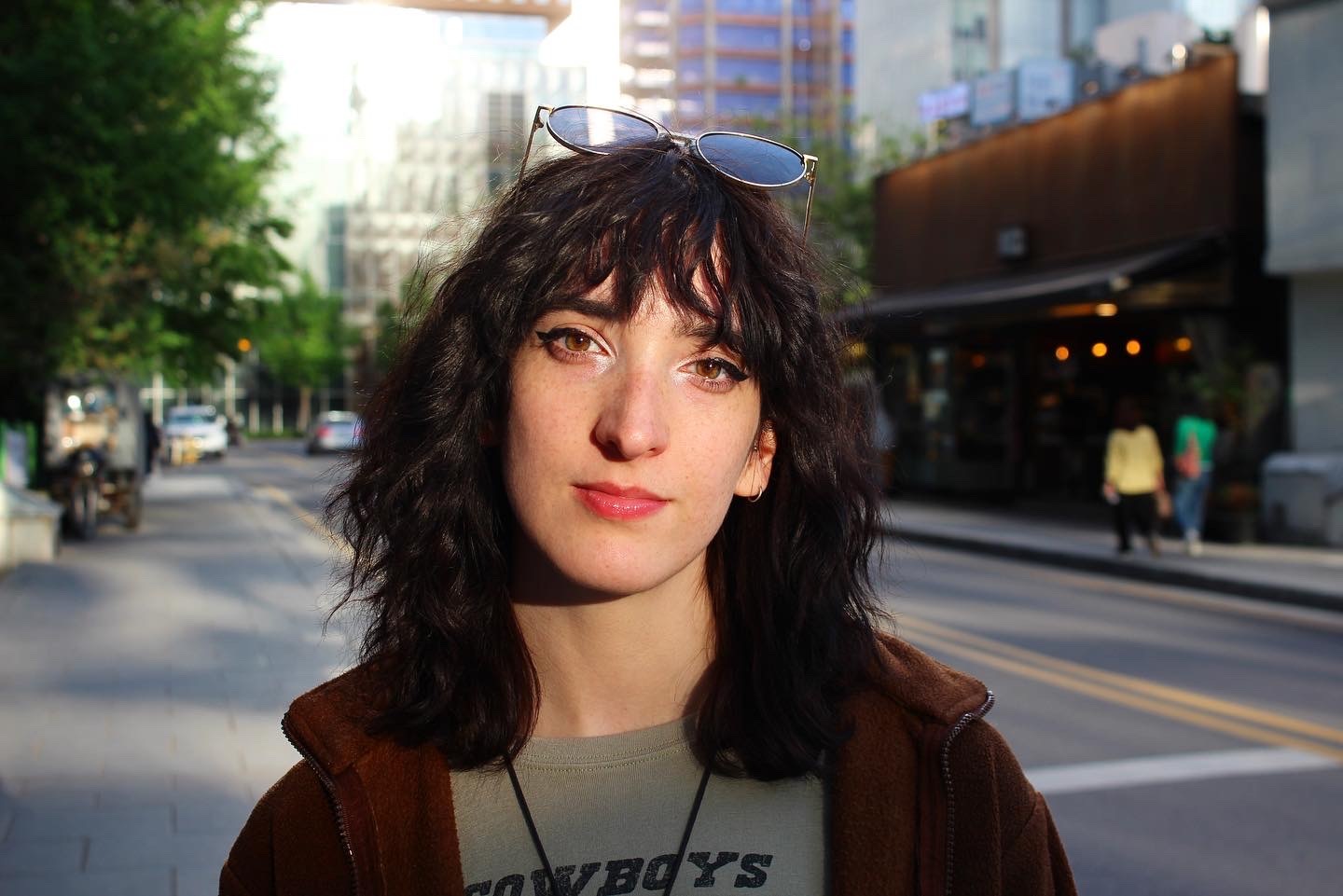
As a former barista (and current product tester), I've spent a lot of time getting hands-on with espresso machines.
After a combined three years at two of the biggest coffee chains and a year at an artisan independent coffee shop, I can detect a well-balanced shot when I taste it, and can also interpret the culprit behind a poor extraction, be it low pressure, grind size, or poor temperature controls.
Spending three years making hundreds of coffees a day might make a person gag at the sight of lattes, but coffee still holds a special place in my heart.
My favorite drink is an oat milk flat white, made with Kenyan or Ethiopian beans.
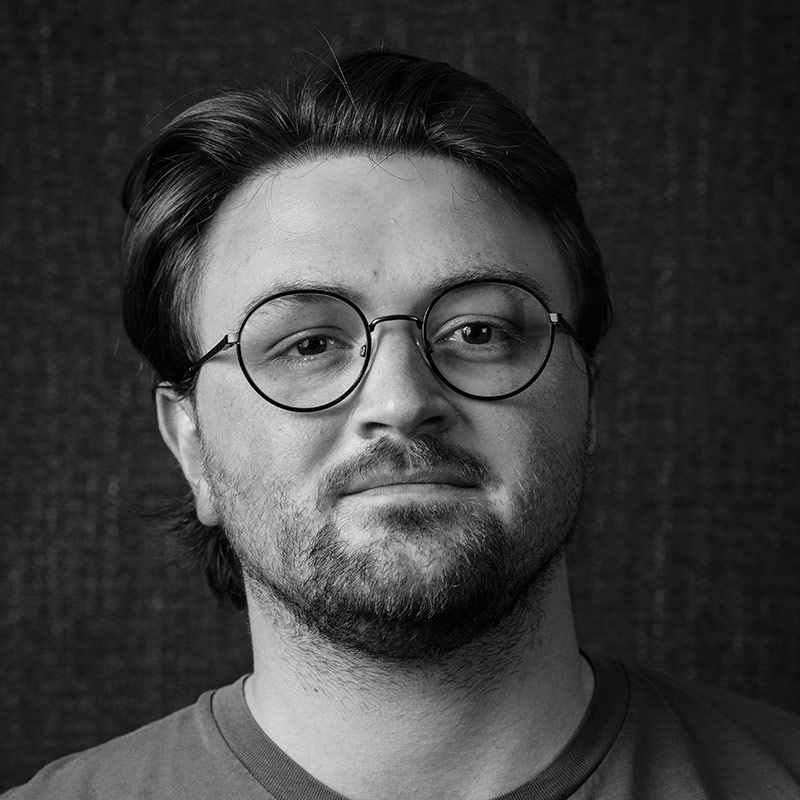
I’m Tom’s Guide's Reviews Editor and I’ve been an espresso enthusiast for almost a decade now.
As a former chef, I started using commercial espresso machines to make tiramisu while working in an Italian restaurant, and that’s where my fascination with 9-bar pressure began. And it hasn’t stopped since.
Fun fact: every job I’ve held since has given me access to espresso machines — oddly enough, that includes when I worked at an energy company, where we had a commercial Expobar machine plumbed into the office kitchen!
These days, I spend large chunks of my day testing out the latest and greatest coffee gear, from coffee grinders and weighing scales through to pour-over drippers and, of course, espresso machines.
I’ve used home espresso machines from Breville/Sage, Rancilio, Gaggia, De’Longhi, Diletta and more. Through my years of testing (and tasting), I have the experience to know when a machine performs as it should and whether or not it’s worth your hard-earned cash.
Also tested
We test a ton of coffee gear at Tom's Guide, and not everything can make it to the final guide. If I don't include something, that doesn't necessarily mean we don't recommend it, so if none of the machines listed above take your fancy, you might get along better with one of these tried-and-tested options.
KitchenAid Semi Automatic Espresso Machine (★★★★☆)
The KitchenAid Semi Automatic Espresso Machine with Burr Grinder is the entry-level option in KitchenAid's line of coffee makers. It's a mid-price, high-quality option, but it lacks a lot of the automated features you'll see from options like Breville and De'Longhi.
Read the full KitchenAid Semi Automatic Espresso Machine review
Rancilio Silvia (V6) (★★★☆☆)
With some trial and error though, Reviews Editor Peter hit his stride with the Silvia. After some experimentation he said he was "actually a little taken aback at how nice espresso shots tasted." If you've got a refined palate and espresso known-how, this could be a good option.
Read the full Rancilio Silvia (V6) Espresso Machine review
De’Longhi Dedica Duo Espresso Machine (★★★☆☆)
The De'Longhi Dedica Duo is a good espresso machine capable of making pleasant cold brew for just $299. Even so, it's the same price as the fantastic Breville Bambino and $150 pricier than our favorite budget machine, the De’Longhi Stilosa.
Read the full De’Longhi Dedica Duo Espresso Machine review
Philips Barista Brew Espresso Machine (★★★☆☆)
The Philips Barista Brew is Philips' first attempt at an automatic coffee machine. The rest of the line is superautomatic, and start at quite affordable prices. When we tested the Barista Brew, we didn't have an issue with the quality of its extraction or construction, it just struggles to break through the very crowded market of machines that look, cost, and perform almost exactly the same.
Read the full Philips Barista Brew Espresso Machine review
Wacaco Minipresso GR2 (★★★★☆)
You probably didn't come to this guide looking for a wireless coffee maker, but this non-electric option is very affordable, super portable, and ideal for travel. It uses a valve to create the pressure needed to extract espresso, and we were really impressed by how well it worked.
Read the full Wacaco Minipresso review
Terra Kaffe TK-02 (★★★★☆)
The Terra Kaffe is super smart. It claims to feature AI tech that will personalize your brew to your specific preferences, and it certainly looks space-age. The price will rule it out of contention for most people though, and it's also a very large option.
Read the full Terra Kaffe TK-02 review
Philips 3200 Series LatteGo (★★★☆☆)
The Philips 3200 Series LatteGo is one of the most affordable superautomatic espresso machines on the market. It feels plasticky in use and the milk dispenser will struggle to compete with more expensive options, but if you want a one-and-done option that doesn't cost the earth, it's a good choice.
Read the full Philips 3200 Series LatteGo review
How do espresso machines work?

If you’re completely new to espresso machines, the thing you have to ask yourself is: “how much time do I want to spend, how much skill do I have, and how much am I prepared to put into this?"
Lucy Dunstan, Product Manager at SMEG
I posed this question to Lucy Dunstan, Product Manager at SMEG and La Pavoni. “It’s quite simple really, it’s all about extracting the flavor from your coffee,” she told me.
“There’s a scientific process for making an espresso. It has to be between 88 and 93°C [190 to 200°F], you have to put about 9 bars of pressure on it, and you want to extract between 25 and 30ml of liquid. So what all these machines do is offer a way of controlling that process.”
There are so many variables that stand between your machine and a perfect espresso. This includes the beans you use, how you grind them, the volume of grounds in your portafilter, the pressure you use when tamping, the temperature stability of your machine, the water pressure exerted, the volume of water pushed into your puck… that’s a non-exhaustive list, and it’s before we even get into milk steaming!
There are so many variables that stand between your machine and a perfect espresso
Here’s what I wish I’d known when I bought my first espresso machine: The more automated features you opt for, the fewer variables you’ll need to worry about. “Sometimes with espresso machines, an entry-level price will actually require more skill,” says Dunstan.
“If you’re completely new to espresso machines, the thing you have to ask yourself is: how much time do I want to spend, how much skill do I have, and how much am I prepared to put into this? So you’re either someone who doesn’t have a lot of time to spend on making your coffee, or you want to delve into that world where you’re getting hands-on."
Why are espresso machines so expensive?
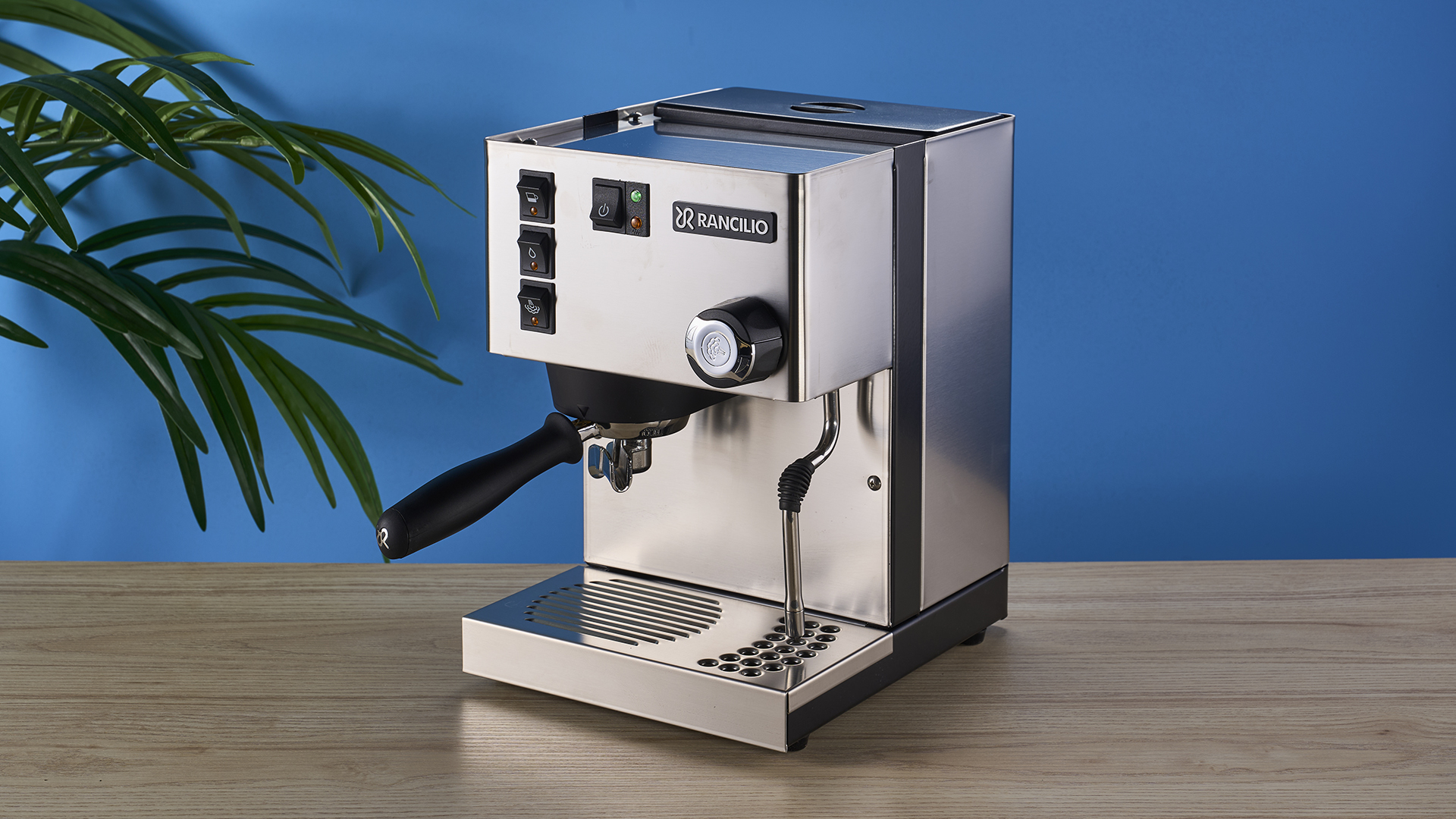
There's an unfortunate irony with espresso machines. You can get good espresso with a cheaper machine, but to do so, you'll need to learn the ins and outs of how these machines work. For the entry-level buyer without much knowledge, you'll often have to spend a lot more on a super-capable machine that will take all the hard work out of the equation.
It doesn't make much sense, right? Coffee enthusiasts can get away with spending $200 on a basic espresso machine because they've got the skill to use it properly, but if you're just dipping your toes in the water? Well, prepare to spend at least $500. It's no wonder why so many people opt for a pod machine like a Keurig or a Nespresso!
Fortunately, the market is catching up. An increasing amount of espresso machines feature assisted settings that will remove some of the variables that can mess up your espresso. This includes automated grinding that controls the volume of coffee dispensed into your portafilter, automated tamping for an even pressure, and even hands-free steam wands that will texture your milk for you.
The majority of the machines I've included in this machine fit into this automatic category in some sense. I think they're the best option for most people, allowing you to learn as you use the machine and get hands-on if you wish, but also taking the reins when you just want a low-effort espresso.
Espresso machine FAQs
Why does pressure matter?
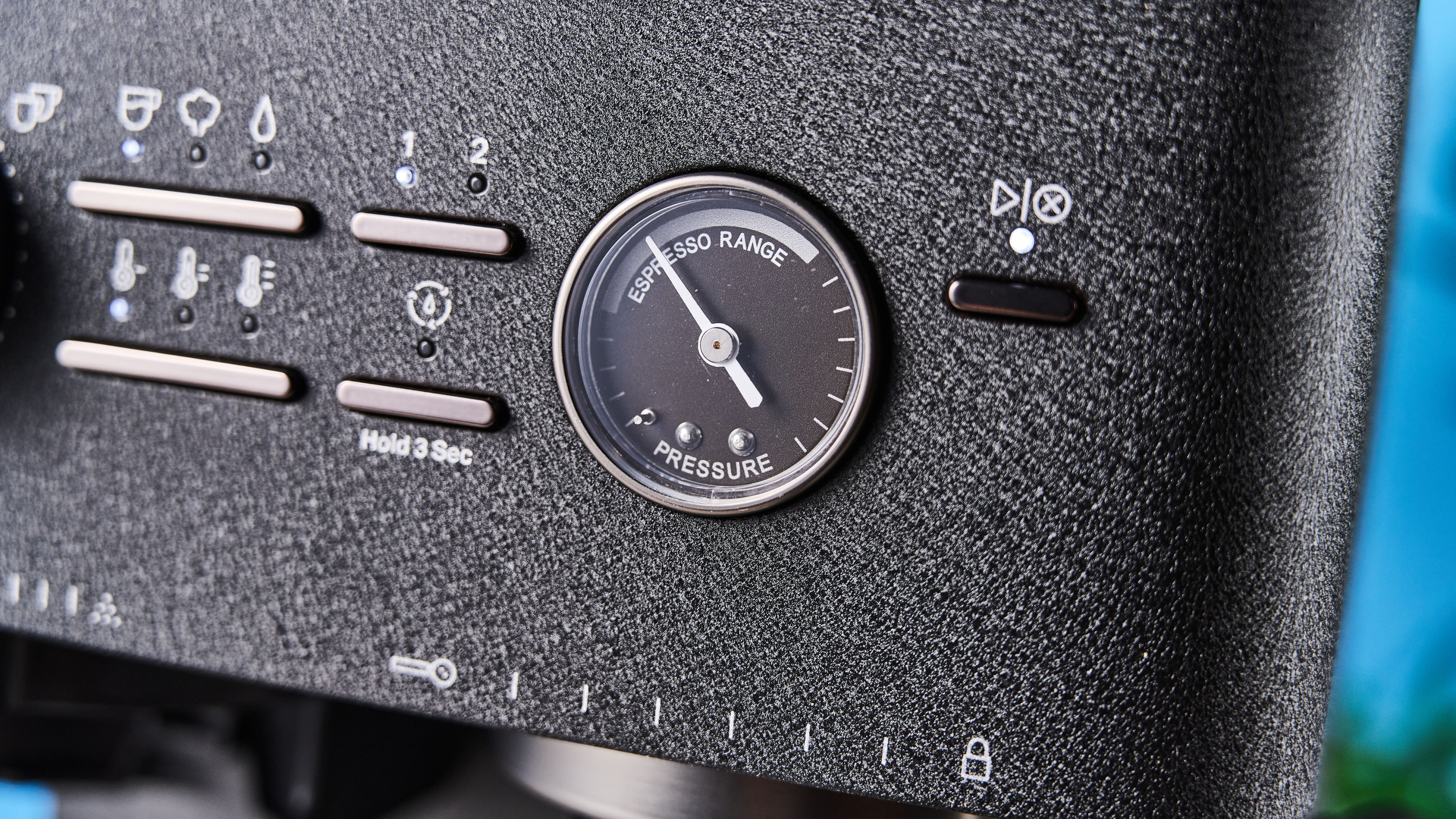
You'll see in the products included I've mentioned how many bars of pressure they each have, but what does this mean, and does it even matter? Well, the short answer is no. You won't necessarily see a better extraction from a machine with 20 bars over a machine with 15. This is because the ideal pressure needed for espresso is 9 bars.
I asked Luke Lane, Training & Events Manager for Sage Appliances, to explain the significance of pressure for espresso machines. "You want to hit 9 bars for optimal extraction," he told me.
"If the pressure is too low, you'll bring out grassy flavors. The pressure won't bring out the sugars from your beans.
"Too high, and your coffee will have a bitter, burnt taste."
If all you need to make a great espresso is 9 bars of pressure, so I asked Lane why so many espresso machines have more?
"Think of it like a car," Lane told me. "You don't want to drive it at top speed all the time, but driving in a comfortable range of what your car is capable of will mean it's not constantly being run flat-out."
He explained that despite the maximum pressure of any machine, they'll use OPVs (which stands for over pressure valves) to keep espresso extraction running at a consistent 9 bars of pressure.
So, while higher pressure doesn't necessarily mean a machine is any better, you might not want to buy a machine with a maximum output of 9 bars, or it could lead to a shorter lifespan for your machine.
Why does basket size matter?
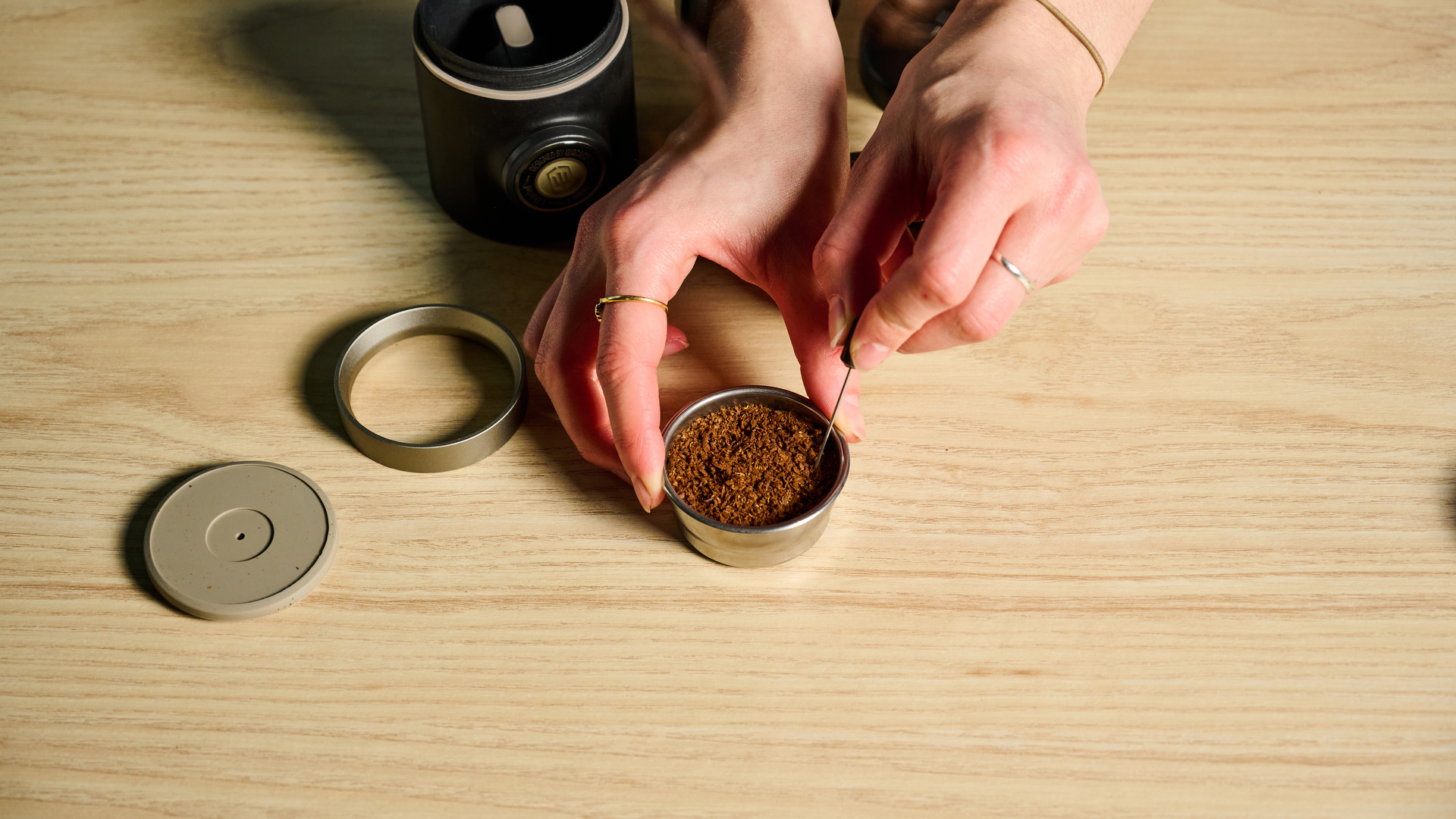
Most espresso machines will come with four baskets: two single and two double, with a mix of double-walled and single-walled constructions. I'll explain the difference between single-walled and double-walled below, but what's the significance of your basket size and capacity?
Luke Lane, Training & Events Manager for Sage Appliances, explained it to me: "There are two main basket widths: 54mm, which features on Sage / Breville's Barista range, and 58mm, which features on our Jet range."
"58mm is considered to be commercial-grade. The larger and shallower basket will give you marginally better results because you're more easily able to permeate all of the grounds inside your basket."
After testing countless espresso machines, I don't think my palette is quite so attuned that I could turn my nose up at an espresso from a 54mm basket. But it's useful to know if you want to replace or upgrade any parts of your machine what size portafilter baskets the group head will fit.
Should I use single-walled or double-walled baskets?

Single-walled and double-walled baskets, also known respectively as unpressurized and pressurized, are included with your espresso machine to give you options. As a general rule of thumb, you'll get better results from a pressurized basket if you're using pre-ground coffee. It will help you overcome some of the shortcomings of a grind size that's too coarse, or coffee that's less fresh. But if you want to taste the authentic flavor of your fresh-ground beans, a single-walled basket is the way to go.
In our reviews, we always use fresh-ground coffee, so we stick to single-walled baskets for the majority of our testing.
When I asked him to explain how pressurized baskets work, Luke Lane, Training & Events Manager for Sage Appliances, said "Think of a group of people running down a hall and having to go through a door." He explained, "That's what the double-walled basket does. It creates pressure by restricting the flow of your coffee, forcing it to build up more flavor and crema than you'd have been able to achieve with a less fresh coffee."
We've done a thorough explainer on this in our guide to pressurized coffee baskets — how do they work and when should you use them? The short answer? They can act as a cheat code to a better espresso if you're not working with the ideal gear, but a machine with an in-built grinder shouldn't need one.
What is the difference between a single boiler, double boiler, and thermoblock?
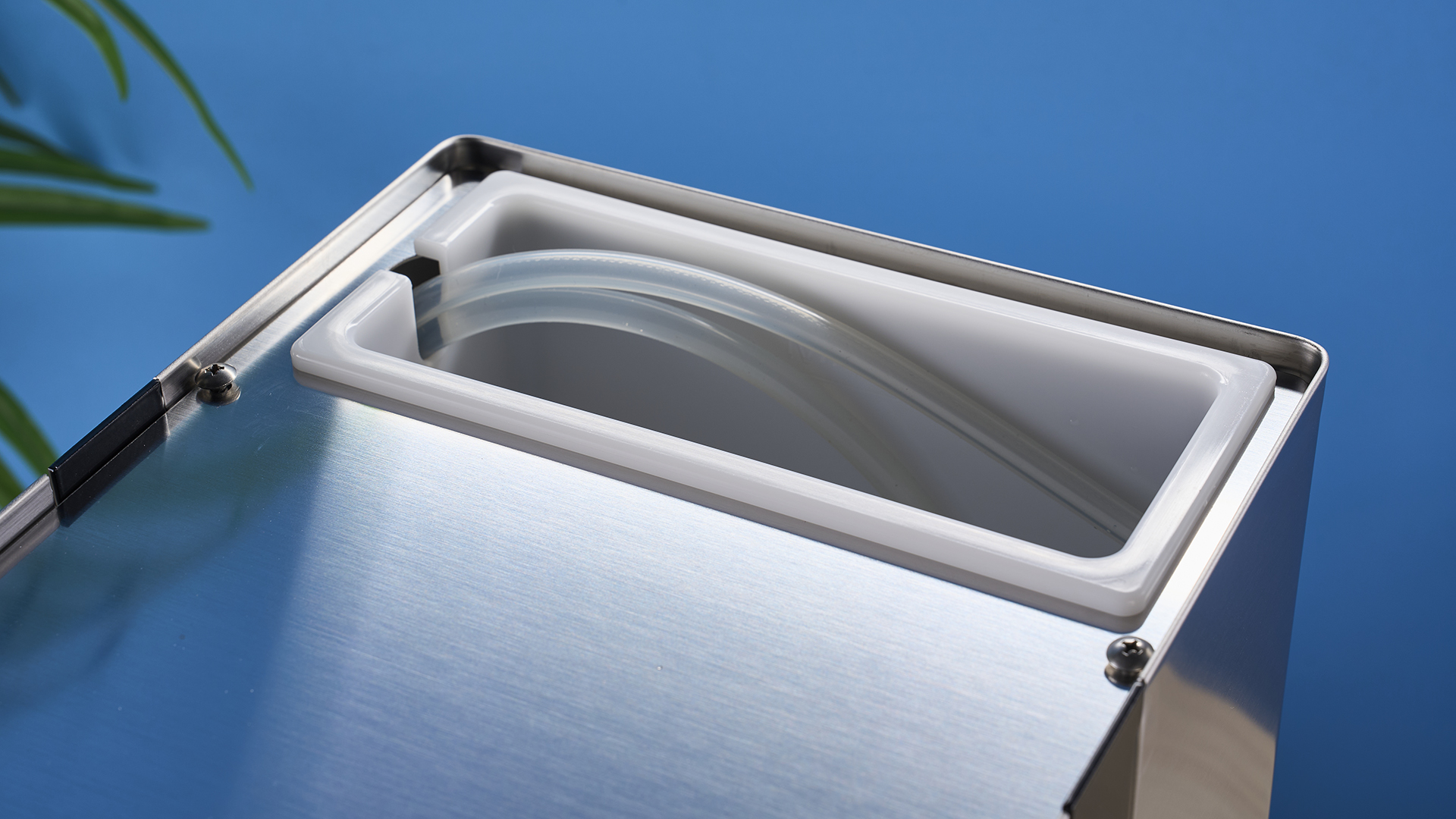
The vast majority of domestic espresso machines use thermoblock technology to heat water on demand. But how does it work, and what are the pros and cons?
There are very few single boiler machines on the market, but the Rancilio Silvia is one of them. Boiler machines will heat your water and keep it at temperature for as and when you decide to use it. A single-boiler uses one boiler for both the group head and the steam wand, which require different temperatures and therefore will need to you purge excess hot water as you use different elements of the machine.
Dual boilers have one boiler for the group head, and another for your steam wand. They're not super popular for domestic, and I've not included a dual-boiler in this guide. They have a higher energy consumption because they keep your water hot for more precision and stability.
What about thermoblock? I asked Lucy Dunstan, Product Manager at SMEG and La Pavoni, to explain. “A thermoblock is a heated metal block with one or more pipes running through it that will rapidly heat water on demand," she explained.
"They’re usually very compact so they don’t take up much space, meaning they can be fitted in smaller machines, and they’re more energy efficient [than a dual boiler].”
“So the advantage is that they’re fast, small, and energy-efficient. The disadvantage is that they offer less temperature consistency than a dual boiler machine.
"And they can, over time, be susceptible to limescale, so they may not last as long. Whereas if you buy a dual boiler La Pavoni machine, and you look after it, I’d expect it to last you a lifetime.”
Get instant access to breaking news, the hottest reviews, great deals and helpful tips.

Millie is the Managing Editor of Homes at Tom's Guide. She's been reviewing home tech for over five years, testing everything from coffee makers to the latest vacuum cleaners.
With particular expertise in cookware and kitchen appliances, you'll struggle to find an air fryer Millie hasn't tested. She's traveled the world reporting on the latest home innovations and product launches, learning how to use pizza ovens from Pizzaiolos in Naples, and touring the De'Longhi factory in Venice. Millie is also an SCA-Certified barista.
When she's not reporting on home and appliance trends, Millie loves watching live music. She's currently learning the guitar - naturally, she plays a Fender.
